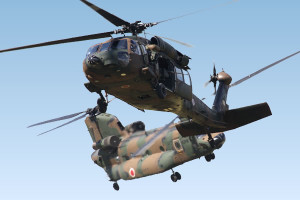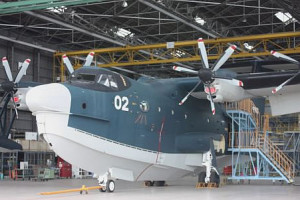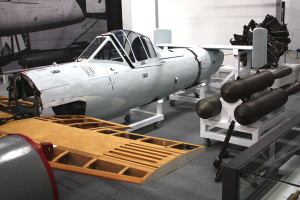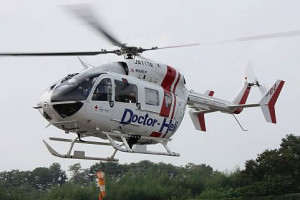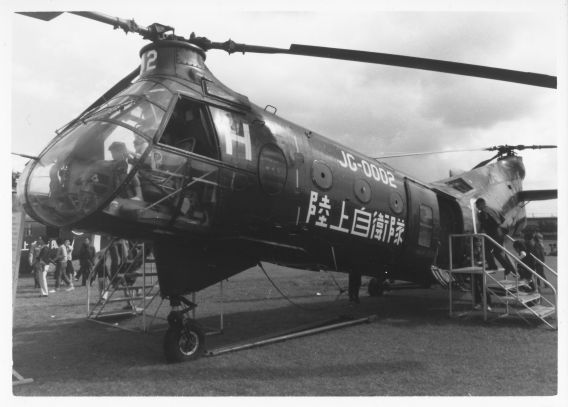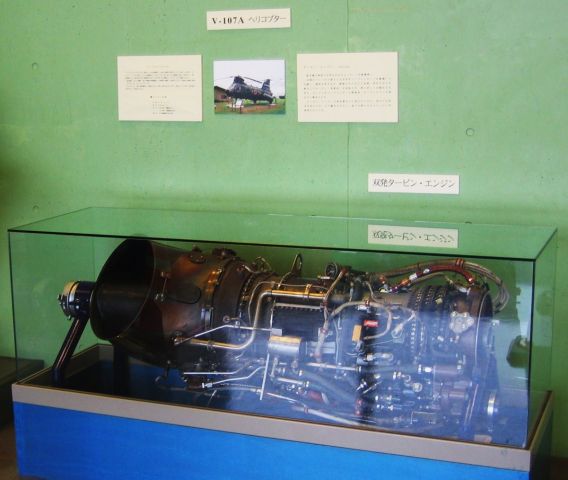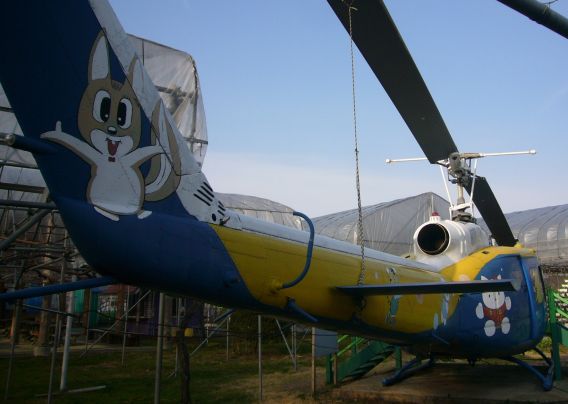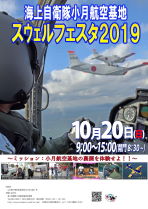JGSDF – Where Are They Now?
As far as is possible, this section will provide the latest information on the whereabouts of surviving examples of withdrawn JGSDF aircraft, which can be found in places far removed from the cosseted shelter of aviation museums. Divided into fixed-wing and helicopter types, the information comes in the form of tables that are being interspersed with a growing number of photos.
 UH-1H 41700 nestles in the bucolic setting of the Fujisan Juku no Mori Park in Shizuoka
UH-1H 41700 nestles in the bucolic setting of the Fujisan Juku no Mori Park in Shizuoka
Prefecture, on a clear day perhaps the most spectacular location of any ex-SDF aircraft.
(Photo [May 2019]: 樹空の森 via facility’s Twitter account @Jukuunomori)
The aircraft are on open-air display unless otherwise stated. Bold-type serial numbers indicate aircraft that appear in photos immediately after the relevant table; where given, months in parentheses the dates non-museum aircraft were last confirmed as still present.
Carried out way back in 2014 to mark the Self-Defense Forces’ 60th anniversary, a census of JGSDF types produced mixed results. Utilizing information gained from the census, two special reports on displayed aircraft were added in a separate section at the very end of the tabular information; a third was added as the result of a visit to Kisarazu in September 2017:
KV-107II at Crossland Oyabe amusement park, Toyama Prefecture
UH-1H at Herb World Akita, Yurihonjo, Akita Prefecture (note that this aircraft was removed in 2019)
KV-107II-4A at Kisarazu Army Camp Museum, Chiba Prefecture
Since the last major update of this page, the remaining dozen or so Hughes TH-55Js have suffered a major cull. Belatedly it was discovered that white asbestos had been used in the manufacture of the engine mount and fuel line cushioning materials. As of this writing (February 2024), only three, if that, remain.
At the other end of the service timescale, the UH-1J is among those aircraft types that have yet to appear on display or serve base ground instruction or publicity purposes. As some of the first examples, which date back to 1989, have likely already been withdrawn from service if not scrapped, the type will become more prominent in second-line use as deliveries of its successor UH-2 get under way.
As a general guide, a colour-coded Where Are They Now? listing by prefecture follows the tabular JMSDF aircraft information [here].
 In a more common or garden location, this weather-beaten JGSDF Beech T-34A Mentor wiles
In a more common or garden location, this weather-beaten JGSDF Beech T-34A Mentor wiles
away its days in a meadow close to the main gate of the service’s Kita-Utsunomiya airfield.
For the purposes of disseminating and promoting its policies as well as for recruitment publicity, the Japan Ministry of Defense provides retired aircraft on free loan to local public entities, certain categories of school, other relevant persons and those who will conduct promotion activities. The loan agreements are renewable on no more than an annual basis. The lessee will be responsible for the costs of transportation, management and upkeep required for the loaned aircraft. Over the years, JGSDF helicopters have been a particularly popular choice.
The lessee will usually follow a four-stage procedure. Firstly, an application will be made to an SDF Regional Cooperation Headquarters, which will act as coordinator between the service’s upper echelons and the unit that will physically provide the loaned aircraft. There then follow the loan application and approval procedures, which if successful will lead to the aircraft being installed on site by SDF personnel.
 A scene from the event held at JGSDF Kasumigaura on March 26, 2020, to mark the coming home
A scene from the event held at JGSDF Kasumigaura on March 26, 2020, to mark the coming home
to roost of the last flights made by JGSDF OH-6Ds. After the photo calls, the 15 aircraft were
pushed one by one into a hangar (link) and an uncertain future.
(Photo: Lien via Twitter @roomskyguard)
Fixed-Wing Types
Beech T-34A Mentor |
|
| Serial | Last Known Location |
| (60501) | Formerly at Higashi-Chitose Army Camp, Hokkaido Prefecture (Photo from April 2016 [link], had been removed by April 2017) |
| 60505 |
JGSDF Obihiro Army Camp, Hokkaido Prefecture (moved from Bihoro Air Park, |
| 60506 | Kita-Utsunomiya Army Camp, Tochigi Prefecture (Pictured above in May 2013, photo from June 2019 [link]) |
| 60508 | On indoor display at Tokorozawa Aviation Museum, Saitama Prefecture (Photos on dedicated museum page [link] and from Dec. 2020 [link]) |
| 60509 | On roof of PR Exhibit Room at Yao Army Camp, Osaka Prefecture (Oct. 2015 [link]) |
| Last updated: Dec. 30, 2020 | |
 Several of the aircraft on display at the Tokorozawa Aviation Museum, including this
Several of the aircraft on display at the Tokorozawa Aviation Museum, including this
1950s-vintage T-34A Mentor, are suspended from the ceiling.
 For many years, the PR Exhibit Room at Yao Army Camp has had this T-34A perched on its roof.
For many years, the PR Exhibit Room at Yao Army Camp has had this T-34A perched on its roof.
(Photo [October 2012]: Hunini via Wikimedia Commons)
Cessna L-19E* Bird Dog |
|
| Serial | Last Known Location |
| 11204 | Reportedly in storage at Kawaguchiko Motor Museum, Yamanashi Prefecture |
| 11209 |
Instructional airframe at Japan Aviation Academy Wajima (JAAW) Noto Airport |
| 11210 |
As 11209 (Photo from Oct. 2016 [link], noted with main wings removed likely |
| 11214 |
Old Car Center KUDAN, Naraha, Futaba District, Fukushima Prefecture |
| 11364 | (L-19E-2) Tachikawa Army Camp, Tokyo (Photos from Sept. 2018 [link] and Oct. 2023 [link]) |
| 11366 | (L-19E-2) Main gate of Kita-Utsunomiya Army Camp, Tochigi Prefecture (Photo immediately below, and from June 2019 [link]) |
|
* L-19E-1 unless otherwise stated. All survivors in Japan are from 22 built under licence by Fuji. |
|
| Last updated: Feb. 25, 2024 | |
 Photographed in May 2013, this L-19E-2 still forms part of the huddle of aircraft parked at
Photographed in May 2013, this L-19E-2 still forms part of the huddle of aircraft parked at
Kita-Utsunomiya Army Camp’s main gate.

Whether by accident or design, the L-19E-2 pictured in the photo (above) in the “engine room”
at the Tachikawa Army Camp museum in November 2017 was the same aircraft as that
parked outside. This particular aircraft was delivered to the JGSDF in March 1960,
withdrawn from use with the 1st AvSqn in December 1986, and previously
displayed at Takigahara Army Camp, Shizuoka Prefecture.
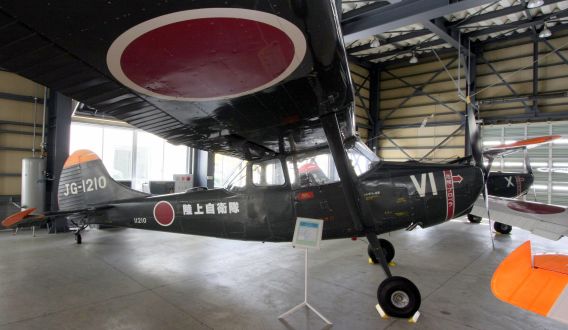 At one stage, Japan Aviation Academy Wajima (JAAW) kept two L-19Es
At one stage, Japan Aviation Academy Wajima (JAAW) kept two L-19Es
in the hangar at its campus at Noto Airport, Ishikawa Prefecture.
(Taken in January 2014, photo courtesy Masayuki Sakamoto, JAAW)
 Reliving their service days, the two JAAW L-19s sit tethered out on the airfield in October 2015.
Reliving their service days, the two JAAW L-19s sit tethered out on the airfield in October 2015.
What became of them? (Photo: i北陸 [i-Hokuriku] / Hokuriku region
official event and tourist destination blog [link])
Where They Went (1) / United States
It is estimated that, within the space of a year from March 1954, 104 Cessna L-19As were passed on initially to the National Security Force (NSF) and then the nascent JGSDF. Although known as the O-1A Bird Dog to the U.S. Army from September 18, 1962, the JGSDF continued to use the old-style designation.
As shown in the table below, a handful of former JGSDF L-19As were ultimately returned to the country of their birth, where they passed into private ownership. Strangely, two were to be involved in separate, fortunately non-fatal accidents while engaged in the towing of advertising banners in Florida in 2014.
Known Former JGSDF L-19As on U.S. Civil Register
| JGSDF | c/n | ex-U.S. Army | U.S. Reg’n | Notes |
| 11017 | 21666 | 51-4781 | N5074G | Now airworthy on UK civil register (See Bulletin Board story Nov. 2021) |
| 11051 | 21198 | 50-1524 | N5022K | Photos from Oct. 1980 (link), July 2009 (link) and Sept. 2019 (link) |
| 11063 | 22031 | 51-11987 | N212KY | Lost power and crashed due fuel starvation when towing banner, off Miami Beach, Florida, Sept. 6, 2014 (See photo below) |
| 11067 | 22956 | 51-12501 | N211PP | Banner towing accident, Tampa Bay, off St. Petersburg, Florida, Mar. 23, 2014 |
| 11096 | 21290 | 50-1597 | N305AB | At Oshkosh July 2015 Photos: Undated (link), July 2022 (link) |
| 11101 | 21714 | 51-4829 | N5073Y | (See photo below) |
 Possibly taken prior to delivery at the Cessna factory in Wichita, Kansas, this undated photo shows
Possibly taken prior to delivery at the Cessna factory in Wichita, Kansas, this undated photo showsthe aircraft that went on to serve with the JGSDF as 11101. First registered in the United States in
May 1986, N5073Y was still current in September 2015, when seen in Keokuk, Iowa [link].
(Photo from March 1952 issue of The World’s Aircraft used with permission of Hobun Shorin Co., Ltd.)
 At the other end of the timeline, this photo shows pristine L-19A (O-1A) N212KY (formerly U.S.
At the other end of the timeline, this photo shows pristine L-19A (O-1A) N212KY (formerly U.S.Army 51-11987 and JGSDF 11063) at North Perry Airport, Florida, in March 2013.
Sadly, this aircraft was to come to grief in a non-fatal accident off Miami Beach, Florida,
in September the following year, when being operated by a banner towing company.
(Photo: André Dupont via Wikimedia Commons)
Where They Went (2) / Royal Thai Army
Thailand is another country where former JGSDF L-19As are to be found, albeit mostly in varying degrees of dilapidation following service with the Royal Thai Army. The survivors include the first of the type to be operated by the NSF, which is now on display as ‘25190’ in U.S. Army markings at the Jesada Technik Museum in Nakhon Chaisi (link). Confusingly, another this time grey-painted former JGSDF aircraft bears the same serial (link).
An article in the February 2018 issue of Kōkū Fan provides a listing of the total of 14 airframes that have been in store at the Jesada Technical Museum since late 2010. Some of the article’s photos are of a huddle of derelict L-19As still bearing crudely painted numbers, as noted back in 2012, which could indicate that they had at one stage been awaiting sale at auction for scrap.
Another intact example is on display at the Royal Thai Army’s Phetchabun Base in Amphor Lomsak (link).
The Foundation for the Preservation and Development of Thai Aircraft (unofficially but more commonly referred to as the Tango Collection) has 10 former JGSDF airframes stored at its Saraburi Aero Park facility and another at Don Muang in Bangkok.
Known Former JGSDF L-19As in Thailand
| JGSDF | RThaiArmy | Current location (if known) |
| 11001 | 1349 | Displayed at Jesada Technik Museum, Nakhon Chaisi, as green (not silver) ‘U.S. Army 25190’ (Photo link in text) |
| 11005 | 4672 | Stored, Tango Collection Saraburi Aero Park |
| 11008 | 1418 | Possibly stored at Jesada Technik Museum |
| 11009 | 1500 | |
| 11011 | 1372 | |
| 11014 | 4717 | Stored, Tango Collection Saraburi Aero Park |
| 11016 | 4834 | Stored, Tango Collection Saraburi Aero Park |
| 11019 | 1716 | |
| 11024 | 1574 | Stored, Tango Collection Saraburi Aero Park |
| 11025 | 4742 | Stored at Jesada Technik Museum (Photo taken Mar. 2012 [link]) |
| 11027 | 1565 | |
| 11028 | 1590 | Stored, Tango Collection Saraburi Aero Park |
| 11029 | 4647 | Stored at Jesada Technik Museum |
| 11031 | 1358 | |
| 11033 | 1659 | |
| 11036 | 1620 | Stored, Tango Collection, Don Muang, Bangkok |
| 11038 | 1603 | Stored, Tango Collection Saraburi Aero Park |
| 11046 | 1490 | Stored, Tango Collection Saraburi Aero Park |
| 11048 | 1607 | Stored at Jesada Technik Museum |
| 11049 | 1634 | Stored, Tango Collection Saraburi Aero Park |
| 11053 | 1562 | Stored, Tango Collection Saraburi Aero Park |
| 11056 | 1510 | |
| 11064 | 2481 | Stored at Jesada Technik Museum |
| 11065 | 1706 | |
| 11066 | 4887 | Displayed at Royal Thai Army Phetchabun Base, Amphor Lomsak |
| 11068 | 2130 | |
| 11070 | 2118 | Stored at Jesada Technik Museum as grey not green ‘25190’ (Photo link in text) |
| 11074 | 2577 | Stored at Jesada Technik Museum |
| 11079 | 2353 | |
| 11080 | 1554 | Stored, Tango Collection Saraburi Aero Park |
| 11084 | 2498 | Stored at Jesada Technik Museum |
| 11085 | 1400 | Stored at Jesada Technik Museum |
| 11088 | 4854 | Stored at Jesada Technik Museum |
| 11091 | 1601 | |
| 11092 | 4699 | Stored at Jesada Technik Museum |
| 11093 | 2003 | Stored at Jesada Technik Museum |
| 11100 | 4792 | Stored at Jesada Technik Museum |
(Source: Kōkū Fan, February 2018)
A Japanese blog includes photos taken during a visit to the Jesada Technik Museum, which also houses a large car collection, in December 2017 (link).
Thai aviation guru Steve Darke maintains his website here (link), which contains a link to copious photos of L-19s/O-1s (link), including those in states of disrepair. Steve also updates an aircraft location listing here (link).
Where They Went (3) / UK Civil Register via Hawaii – See Bulletin Board story for November 2021.
Fuji LM Variants* |
|
| Former Serial | Notes |
| 21001 | (c/n LM1-3) ff (then as JGSDF `2011′) Sept. 8, 1956, delivered Oct. 2, 1956 Listed as exported to U.S. after wfu June 13, 1977, although photographed after retirement on display at Akeno Army Camp in Mar. 1988 (link) → N6335W Registration cancelled Feb. 2018 |
| 21002 |
(LM1-4) Exported to U.S. after wfu Mar. 31, 1978 |
| 21007 |
(LM1-9) Photo at Iruma AB Oct. 1973 (link) Ownership registered in Oklahoma since June 2017, same owner also registered |
| 21008 |
(LM1-11) Exported to U.S. after wfu Dec. 16, 1981 |
| 21010 |
(LM1-13) Photo at Yao May 1979 (link) |
| 21011 |
(LM1-14) Exported to U.S. after wfu Mar. 31, 1978 Still on register (owner in Lynchburg, VA, Dec. 2016) |
| 21012 |
(LM1-15) Photo at JGSDF Iwanuma Branch School 1966 (link) |
| 21014 |
(LM1-17) Exported to U.S. after wfu June 12, 1980 |
| 21017 |
(LM1-20) Exported to U.S. after wfu June 12, 1980 Owned by company in Brighton, CO |
| 21019 |
(LM1-22) Photo at Akeno Oct. 1978 (link), exported to U.S. after wfu June 12, 1980 |
| 21020 |
(LM1-23) Photo at Akeno Oct. 1979 (link), exported to U.S. after wfu Dec. 16, 1981 |
| 21022 |
(LM1-25) Photo at Takayubaru Apr. 1978 (link), exported to U.S. after wfu June 12, 1980 → N2105X 1989 (link) Currently registered to owner in Pennsylvania (photo from Sept. 2013 [link]) |
| 21051 |
(LM-2, ex LM-1 21016, c/n LM1-19) |
| 21052 |
(LM-2, ex LM-1 21026, c/n LM1-28) |
| 21053 |
(LM-2, ex LM-1 21024, c/n LM1-10) |
|
(*) All LM-1 with exception of last three, which were those LM-1s converted to LM-2 standard. |
|
| Last updated: June 25, 2024 | |
The JGSDF had the misfortune to suffer the loss of four LM-1s, three of which were during the course of normal operations: 21018, which was wrecked at Takayubaru airfield (today Takayubaru Army Camp), Kumamoto Prefecture on December 10, 1959; 21023, which crashed in the mountains above the then town of Uchinomi on Shodo Is., Kagawa Prefecture, when flying across the Inland Sea en route from Takayubaru (Kumamoto) to Yao (Osaka) on August 1, 1968, claiming the lives of all three on board; and 21009 the following week, on August 7, 1968, in the Mt. Yoshino area of Nara Prefecture, while searching for 21023.
自衛隊機乗り逃げ事件
Mystery Disappearance – JGSDF “Stolen Ride Incident”, June 1973
To this day, the other LM-1 loss remains shrouded in a true “Where is it now?” mystery. The story goes that an aircraft was taken without permission, in effect stolen, the perpetrator being a then 20-year-old JGSDF ground crewman who was undergoing training to be a pilot at the Utsunomiya School.
Under cover of darkness at around 21:00 on June 23, 1973, a Sgt. Yukio Kayano managed to singlehandedly take the aircraft (21005, seen here at Matsushima in July 1964 [link]) from a hangar at the airfield, which at that time of night was, at least in theory, closed for operations.
As reported in the September 1973 edition of Aireview magazine, the aircraft had been parked at the front of the No. 2 Hangar, which at the time had contained 10 L-19s and seven other LM-1s. An incriminating sergeant’s cap had been found in the hangar.
According to media reports marking the 45th anniversary of the incident in 2018, Sgt. Kayano had previously been seen drinking in a mess bar. No other evidence about what night have prompted his actions or about his mental state have ever come to light.
Not surprisingly, the unauthorized flight did not go entirely undetected as at least one eyewitness had seen the aircraft heading south, but by staying at low altitude Sgt. Kayano managed to evade detection by all three JASDF radar sites in the area. (This was three years prior to the somewhat higher profile incident involving a defecting Soviet pilot, who landed a MiG-25 at Hakodate Airport, Hokkaido Prefecture.) All subsequent attempts to establish radio contact went unanswered, either intentionally or because the tyro pilot had yet to receive tuition on how to operate the aircraft’s communications equipment.
Assuming that the aircraft was parked with full tanks, its range would have been around 1,300 km, enough to remain airborne for just over five hours. As a mechanic, Sgt. Kayano had accumulated all of 2hrs 10mins on the LM-1 and 6hrs 45mins on helicopters when accompanying bona fide crews on post-maintenance checks. Although he was due to sit the pilot’s exam, the exact stage of training that he had reached is not known.
A month-long search was initiated by the SDF and police, with the coast guard also called in on the basis of around 70 reports from residents who had heard an aircraft that night. These seemed to indicate that the aircraft had headed for the Mito/Katsuta area in neighbouring Ibaraki Prefecture and then out over the Pacific Ocean. This incident took place during Japan’s rainy season, so the weather might have been a factor, but no trace was ever found.
In the end, Sgt. Kayano was officially discharged from the service in absentia on disciplinary grounds (whereabouts unknown) on August 1 that same year, and seven JGSDF personnel reprimanded for failing in their responsibilities with regard to the aircraft’s management and safekeeping.
Although J-HangarSpace has been unable to find any date and location information, apparently an SDF hangar fire had previously resulted in the loss of at least one aircraft and other assets. A subsequent investigation had found that the hangar doors had been locked and so, in hoping to learn from that lesson, doors were thereafter only to be bolted from the outside in case there was an emergency. They had reckoned without the thought processes of an inebriated young pilot’s desire to take an ill-advised and ultimately ill-fated flight.
Triumphs and Tragedies during U.S. Ownership History
From the above data table, it seems that at least 15 of the 23 LMs that remained were eventually passed to U.S. ownership, where they became popular participants at air displays and fly-ins.
Although hardly a “warbird”, the type was one of those adopted by, among others, the Valiant Air Command (VAC) warbird group, an educational organization that dates back to 1977.
Quite early in the U.S. chapter of the type’s history, on January 1, 1985, two LM-1s were performing a formation display at Odessa Airport, Florida. One of them, N2104X, was fully laden with a pilot and three passengers, all of whom were potential VAC members. According to the accident report, its pilot displayed poor judgement when attempting to execute a low-altitude loop, which resulted in the aircraft impacting the ground mid-manoeuvre and skidding across an apron on its belly into some parked aircraft before coming to rest. Although two of the occupants were taken to hospital in serious condition, the other two luckily sustained only minor injuries.
 A world away from its future and all-too brief second career in the United States, this shows N2104X
A world away from its future and all-too brief second career in the United States, this shows N2104X
as newish JGSDF recruit 21014 at Oita Airport in 1957, when assigned to the 4th Aviation Corps at
Metabaru, Saga Prefecture. Another image (link) shows the same aircraft looking spick and
span at Akeno in October 1979. (Photo: Takao Kadokami)
On June 29, 1991, the LM pilot community suffered the tragic loss of two of its members. They were flying the third (LM-1 N2109L) and fourth (LM-2 N2100J) aircraft in a four-aircraft formation when their wings touched during a performance at Keystone Heights Airport in Florida.
One other incident occurred at Athens Ben Epps Airport in Georgia on October 22, 2009. The aircraft (N2121J) had only been flown for 30 hours in the two years prior to the accident, because the owner had surrendered his FAA medical certificate and moved to another state. A pilot-rated acquaintance was accompanying him in bringing the aircraft across. On takeoff, the aircraft was seen to stall for reasons that could not be determined with any accuracy by the subsequent investigation into the accident, which claimed the lives of both men.
By 2016, no less than 11 LMs were in the possession of Headquarters Squadron War Planes (HSWP) at two locations in Connecticut. In various states of disrepair, they had been amassed over the years by a collector named Peter Palo and, following his death at the age of 95 in 2012, were being put up for sale by his nephew.
The majority of these aircraft, which included N6335W, were in Putnam, Connecticut, the only exception was N122TF, which was located in the town of Andover. A Japanese resident sent a report to the hikokikumo.net site that stated that N122TF, which had 6,320 flying hours on its airframe, was in a disassembled state and that its engine had only 606 hours. Its special low price was $15,000, less than what a low-hour engine alone would cost. As they had been cannibalized for parts common with the T-34 Mentor and were being stored in the open air, the asking prices for the other aircraft were: fuselage only, $2,000; a fuselage with engine, $3,000; and fuselage, wings and engine for $5,000. The prices obviously took into account the desire for a quick sale and the expenses associated with assembly and, were that the intention, registration paperwork. A “restored” example was on offer for $35,000.
 The above-mentioned LM-1 N122TF well turned out at a Confederate Air Force event at
The above-mentioned LM-1 N122TF well turned out at a Confederate Air Force event at
Midland, Texas, in October 2012. (Photo: Andy Binks)
Sadly, the costs involved have worked against any repatriations to Japan, where the Tokorozawa Aviation Museum would have been an ideal beneficiary.
 Another ill-fated LM-1 in its previous JGSDF guise at Oita Airport, 21024, the later N2121J
Another ill-fated LM-1 in its previous JGSDF guise at Oita Airport, 21024, the later N2121J
(Photo [Nov. 1960]: Takao Kadokami)
Camera-eager N8020K
One of those imported and sold by HSWP, this LM-1 in particular has over the years been a regular visitor to airshows and filler of the viewfinders of visiting photographers. These days, the aircraft even has its very own Facebook page (link).
 Bearing crudely written Japanese titling, N8020K is seen here at Lakeland Linder International
Bearing crudely written Japanese titling, N8020K is seen here at Lakeland Linder International
Airport, Florida, in April 2009. Still airworthy, the aircraft is currently registered to an
owner in Virginia. (Photo: RuthAS via Wikimedia Commons)
 Taxying during Oshkosh 2016. (Photo [posted Jan. 2016]: Skies of Glory via Twitter @violetpilot1)
Taxying during Oshkosh 2016. (Photo [posted Jan. 2016]: Skies of Glory via Twitter @violetpilot1)
 At the show marking the 75th anniversary of Naval Air Station Oceana, Virginia, in September 2018.
At the show marking the 75th anniversary of Naval Air Station Oceana, Virginia, in September 2018.
(Photo: Monica E. Del Coro/Tomas Del Coro via Wikimedia Commons)
 N8020K again at Lakeland Linder International Airport, Florida
N8020K again at Lakeland Linder International Airport, Florida
(Photo [uploaded Oct. 2020]: Abel Villalobos via Twitter @altimox)
 A closer look at N8020K, at Shenandoah Valley Regional Airport in Weyers Cave,
A closer look at N8020K, at Shenandoah Valley Regional Airport in Weyers Cave,
Virginia, April 2024. (Photo: Chad Kennedy)
LMs on YouTube
N2105N (Video posted Oct. 2015 [link])
View from inside the cockpit on a flight along a coastline. The Japanese beneath the compass (left) warns that the landing gear and flaps must not be lowered at airspeeds in excess of 109 knots.
N2109Z (Video posted in Dec. 2020 [link])
 A prospective buyer provides a great look around and inside N2109Z inside a hangar at Centennial Airport in Denver, Colorado. Note that this LM, like in certain other cases, erroneously sports a JASDF rather than a JGSDF badge on its nose. This aircraft has also had its standard two-bladed prop replaced by a three-bladed version, as was fitted to the LM-2. A series of photos of this aircraft, including one of the instrument panel, can be found here (link).
A prospective buyer provides a great look around and inside N2109Z inside a hangar at Centennial Airport in Denver, Colorado. Note that this LM, like in certain other cases, erroneously sports a JASDF rather than a JGSDF badge on its nose. This aircraft has also had its standard two-bladed prop replaced by a three-bladed version, as was fitted to the LM-2. A series of photos of this aircraft, including one of the instrument panel, can be found here (link).
N8020K, as featured above (Video posted in Aug. 2017 [link])
 Shows the aircraft taking off from New London Airport, Virginia
Shows the aircraft taking off from New London Airport, Virginia
 This photo provides a comparison with the instrument panel photos seen in the videos and in the
This photo provides a comparison with the instrument panel photos seen in the videos and in the
photos of N2109Z. Here, the landing gear and flap warning appears in English beneath the coaming.
(Photo [undated, location unknown]: San Diego Air & Space Museum via Wikimedia Commons)
Kawasaki KAL-2 |
|
| Serial | Location |
| 20001 |
On indoor display at Tokorozawa Aviation Museum, Saitama Prefecture |
| Last updated: Nov. 19, 2019 | |
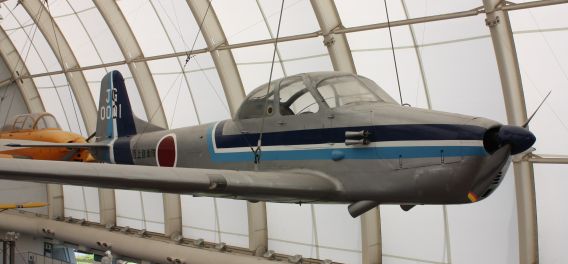 Originally delivered to the nascent JASDF for testing in December 1954, this is one of
Originally delivered to the nascent JASDF for testing in December 1954, this is one of
only two KAL-2s ever built. Its sister was scrapped after serving with the JMSDF.
Mitsubishi LR-1 |
|
| Serial | Last Known Location |
| (22001) | Reportedly damaged in landing accident Sept. 1974, scrapped (date unknown) after having been used for instructional purposes at JGSDF Kasumigaura Aviation School, Ibaraki Prefecture |
| 22003 | Tachikawa Army Camp, Tokyo (Photos from Sept. 2018 [link], Oct. 2023 [link]) |
| 22004 |
Mitsu Seiki Co., Ltd., 301 Shimogawai, Awaji, Hyogo Prefecture 656-1522 |
| 22006 | Main gate at Kita-Utsunomiya Army Camp, Tochigi Prefecture (Photos from June 2019 [link] and May 2023 [link]) |
| 22007 | Instructional airframe at Narita Aeronautics College, 1842 Toride-Nishino, Toride City, Ibaraki Prefecture 302-0004 (April 2017) |
| 22008 | Kasuminome Army Camp, Miyagi Prefecture (Photos from July 2016 [link] Apr. 2019 [link], and Aug. 2022 [link]; and of instrument panel July 2016 [link]) |
| 22009 |
Misawa Aviation & Science Museum, Misawa, Aomori Prefecture |
| 22010 | Shizuoka Institute of Science and Technology, Fukuroi, Shizuoka Prefecture (Photos from Mar. 2013 [link] and, at Hamamatsu AB, Sept. 2020 [link]) |
| 22013 | Kita-Kumamoto Army Camp, Kumamoto Prefecture (Apr. 2019 [link]) |
| 22014 | Jinmachi Army Camp, Higashine, Yamagata Prefecture (May 2023 [link]) |
| 22016 | (Painted as formerly based 22019) Naha Army Camp, Okinawa Prefecture (June 2020, see photo below; photo from Nov. 2022 [link]) |
| 22019 | Possibly still at Kisarazu Army Camp, Chiba Prefecture (see 22016) |
| 22020 | Outside Kisarazu Army Camp Museum, Chiba Prefecture (Photos from Dec. 2019 [link] and Oct. 2023 [link]) |
| Last updated: Feb. 25, 2024 | |
 A high proportion of LR-1 aircraft—the JGSDF’s liaison/reconnaissance version of the Mitsubishi
A high proportion of LR-1 aircraft—the JGSDF’s liaison/reconnaissance version of the Mitsubishi
MU-2 business turboprop—were placed at the gates of army camps upon retirement.
This is 22006, on the main gate at Kita-Utsunomiya Army Camp in May 2013.
 Delivered in March 1972, the third LR-1 built served with the Eastern Region Headquarters Flight
Delivered in March 1972, the third LR-1 built served with the Eastern Region Headquarters Flight
at Tachikawa, where the aircraft has thus far spent its retirement.
 Delivered to the JGSDF in 1976, the LR-1 now at the Narita Aeronautics College in Toride City,
Delivered to the JGSDF in 1976, the LR-1 now at the Narita Aeronautics College in Toride City,
Ibaraki Prefecture, was a long-term resident at Yao, Osaka Prefecture, with the Central
Region HQ Flight. Initially painted black overall (as seen in the above photo), the
aircraft sported World War II-like green and brown camouflage in the 90s.
Today, 22007 still bears the low-viz scheme, tail marking and nose ‘M’
(for ‘middle’) from its last days at the Central Region.
(Above photo [Yao, March 1980]: Takao Kadokami)
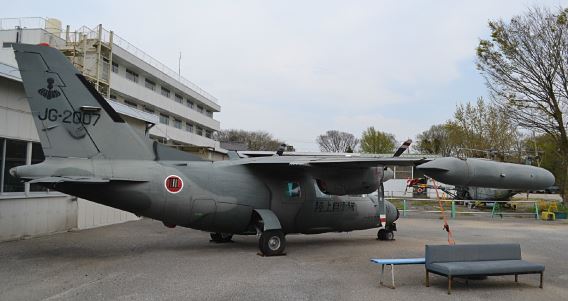 (Photo [Narita Aeronautics College, April 2017]: Warren Hardcastle)
(Photo [Narita Aeronautics College, April 2017]: Warren Hardcastle)
 LR-1 22009 had served with the Western Army following its delivery in March 1978 but was with the
LR-1 22009 had served with the Western Army following its delivery in March 1978 but was with the
Eastern Army at the time of its retirement in 2006. The aircraft was added to the Sky Plaza exhibits
at the Misawa Aviation & Science Museum in November that year.
(Photo [Dec. 2019]: Warren Hardcastle)
 (Above and below) The albeit partially obscured view of the Jinmachi LR-1 in its fenced-off
(Above and below) The albeit partially obscured view of the Jinmachi LR-1 in its fenced-off
paddock in April 2014 provides a comparison with a more recent image,
in which the aircraft is looking a bit down in the dumps.
 (Photos: [Top] contri via Wikimedia Commons; [above, undated] Jinmachi Army Camp
(Photos: [Top] contri via Wikimedia Commons; [above, undated] Jinmachi Army Camp
PR Center website [link], accessed Feb. 2024) )
 (Photo [June 2020]: JGSDF 15th Brigade via Twitter @jgsdf_15b_pr)
(Photo [June 2020]: JGSDF 15th Brigade via Twitter @jgsdf_15b_pr)
Taken during maintenance carried out over the first three days of June 2020, the above photo of the LR-1 (actually 22016) at Naha Army Camp shows that, despite being open to the elements, the aircraft is being kept in good condition. The aircraft benefits from being part of a memorial to the LR-1 crew who lost their lives on active service when flying 22012 during an air ambulance mission in February 1990. The real 22019, which was the first assigned to the then 101st AvSqn and still present when operations of the type from Naha ceased in May 2010, ended its days at Kisarazu (see below).
 A scene from the past: LR-1 22019 is prepared for towing at Kisarazu, October 2012. The last
A scene from the past: LR-1 22019 is prepared for towing at Kisarazu, October 2012. The last
examples having entered service in 1984, the type was gradually replaced by the LR-2 and
the one remaining withdrawn from service after its final flight, on February 15, 2016.
After 18 years based at Naha, Okinawa Prefecture, 220019 had initially been
moved to Kisarazu-based 1st Helicopter Brigade on October 29, 2010, and
been the last LR-1 to appear at a Kita-Utsunomiya open day in May 2012.
The aircraft amassed a total of 7,490 flight hours in its service career.
In honour of its sterling service in Okinawa, 220016 was repainted as
its sister aircraft and placed on display at Naha (as related above).
 The 20th and last LR-1 built on display at the Kisarazu Army Camp open day in September 2017.
The 20th and last LR-1 built on display at the Kisarazu Army Camp open day in September 2017.
The 1st Helicopter Brigade uploaded to its Facebook account a video of time-lapse footage,
dated December 4, 2018, showing the aircraft being moved to its now permanent
home in front of the base museum (link).
Piper L-21B Super Cub |
|
| Serial | Location |
| 12032 |
On indoor display at Tokorozawa Aviation Museum, Saitama Prefecture |
| 12045 |
Kawaguchiko Motor Museum, Fujizakura Highland, Narusawa, |
| Last updated: Nov. 19, 2019 | |
 The Piper L-21B at Tokorozawa was originally donated to the National Security Force
The Piper L-21B at Tokorozawa was originally donated to the National Security Force
(NSF)—the JGSDF’s immediate forerunner—in 1953. To the left can be seen the
Planes of Fame Mitsubishi Zero that was resident at Tokorozawa for a time in 2013.
Stinson L-5E Sentinel |
|
| Serial | Location |
| ”535025″ | (Original serial possibly 10303) On indoor display at Tokorozawa Aviation Museum, Saitama Prefecture (photos below and on dedicated museum page [link]) |
| Last updated: Nov. 19, 2019 | |
 A total of around 40 Stinson L-5 Sentinel aircraft are believed to have served in Japan.
A total of around 40 Stinson L-5 Sentinel aircraft are believed to have served in Japan.
The example at Tokorozawa was delivered in 1952 for the National Police Reserve
(NPR) but saw service with the NSF.
 The spacious area outside the public relations building at Hachinohe Army Camp has been the
The spacious area outside the public relations building at Hachinohe Army Camp has been the
long-term home of three retired helicopters: UH-1H 41662; TH-55J 61336; and OH-6D 31178.
(Photo [early 2019]: JGSDF Northeastern Army)
 Likewise this OH-6J/UH-1H duo forms part of the collection at Ainoura Army Camp in
Likewise this OH-6J/UH-1H duo forms part of the collection at Ainoura Army Camp in
Sasebo, Nagasaki Prefecture. (Photo [undated]: うみみち via Twitter @shimabarakko)
 Two inmates at The Old Car Center in Naraha, Fukushima Prefecture. Although bearing the
Two inmates at The Old Car Center in Naraha, Fukushima Prefecture. Although bearing the
serial number 30216, the H-13KH (left) was originally delivered to the JGSDF as 30217 in
late September 1966, withdrawn from use almost 13 years to the day later, and displayed at
Kasumigaura in the early 1980s. Although still present in September 2020, the TH-55J
likely fell victim to the “asbestos blight” that ravaged the surviving examples of this
type during the course of that year. (Photo [Dec. 2019]: Warren Hardcastle)

Withdrawn JGSDF helicopters often serve out their time as maintenance training airframes.
Used for that purpose by Eastern Army Aviation, Fuji-Bell UH-1H 41714 (above) and
former 11th AvSqn Kawasaki-Hughes OH-6D 31173 (below) were paraded on
specialized trucks at Tachikawa Army Camp in November 2013. The yellow
stickers on both aircraft proclaimed the 40th anniversary of the return of
the first part of the base from U.S. to Japanese control on June 30, 1973.
Although withdrawn from active service, late-model UH-1H 41714 was for a number of years adorned with colour schemes to coincide with Tachikawa’s autumn open days.
Tachikawa Eastern Army Avaition Group 50th Anniversary Nov. 2012
Left side (link); right side (link); nose (link)
The abbreviation EAAFM on the fuselage door stood for Eastern Army Aircraft Field Maintenance.
Tachikawa 40th Anniversary Nov. 2013 (as above)
Right side, on trailer (link); tail boom “Since 1973” (link)
Tachikawa 43rd Disaster Prevention Aviation Festival Oct. 2016
Special marking 43the [sic] Disaster prevention aviation festival
Right side (link); right side fuselage (link)
Left side (link); left side tail boom (link); nose (link)
Tachikawa 44th Disaster Prevention Aviation Festival Oct. 2017
Right side (link)
Eurocopter (Aérospatiale) AS332L Super Puma |
|
| Serial | Last Known Location |
| 00001 | Ex JA9629. In store at Kasumigaura Army Camp, Ibaraki Prefecture, since 2006, sold to New Zealand early 2018 (see photo below) Oceania NZ 2018 → VH-HRP 2020 → C-GSOF 2022 |
| 00002 | Possibly still in store, Kasumigaura Army Camp, Ibaraki Prefecture |
| 00003 |
Ex JA9631, stored then sold (as 00001) |
| Last updated: Feb. 28, 2024 | |
 One of the two former JGSDF AS322Ls acquired by Oceania Aviation of New Zealand is
One of the two former JGSDF AS322Ls acquired by Oceania Aviation of New Zealand is
unloaded from a trailer at the company’s hangar at Ardmore, near Auckland, in April
2018. Having been in storage for 11 years, they eventually found a new owner
following a bidding process commenced in December 2017.
(Photo: Oceania Aviation Limited)
Fuji-Bell AH-1S Cobra |
|
| Serial | Last Known Location |
| 73401 | On indoor display at JGSDF Public Information Center, 4-6 Sakaecho, Asaka, Saitama Prefecture |
| 73402 | Instructional airframe at JGSDF Kasumigaura Aviation School, Ibaraki Prefecture |
| Last updated: Jan. 10, 2021 | |
 The first JGSDF AH-1S Cobra is given pride of place on the ground floor of the service’s
The first JGSDF AH-1S Cobra is given pride of place on the ground floor of the service’s
Public Information Center at Asaka, Saitama Prefecture, which passed the
1.5 million visitor mark on Nov. 9, 2014.
Fuji-Bell UH-1B (Part 1/2) |
|
| Serial | Last Known Location |
| 41503 | Beppu Army Camp, Oita Prefecture (Possibly replaced by UH-1H 41657) |
| 41506 | Above entrance to TENPOS kitchen equipment recycle centre in Chokushicho, Takamatsu, Kagawa Prefecture (July 2018 [link]) |
| 41507 | Nayoro Army Camp, Hokkaido Prefecture (believed still present) |
| 41508 | Nihonbara Army Camp, Okayama Prefecture (Oct. 2017) |
| 41514 | Utsunomiya Army Camp, Tochigi Prefecture (June 2019 [link]) |
| 41524 | Converted into flight simulator and displayed at Tochigi Science Museum, 567 Nishikawada-machi, Utsunomiya, Tochigi 321-0151 (current) |
| 41528 | Yonago Army Camp, Tottori Prefecture (June 2014) |
| 41531 | (As “41581”) Old Car Center KUDAN, Naraha, Futaba District, Fukushima Prefecture (photos from Aug. 2009 [link] and Dec. 2020 [link]) |
| 41543 | Instructional airframe at Bihoro Army Camp, Hokkaido Prefecture (Apr. 2020) (Photos of all Bihoro aircraft up to July 2018 [link]) |
| 41547 |
In indoor exhibition area, Tokorozawa Aviation Museum, Saitama Prefecture (Current, photos on dedicated museum page [link] and from Dec. 2020 [link]) |
| 41557 |
Toyokawa Army Camp, Aichi Prefecture (Apr. 2018 [link]) |
| 41558 |
Engaru Army Camp, Mombetsu District, Hokkaido Prefecture (Apr. 2020) |
| 41559 | Instructional airframe at Shinodayama Army Camp, Izumi, Osaka Prefecture (Believed still present, photo from Apr. 2017 since removed) |
| Last updated: Feb. 21, 2024 / Continued in Part 2 below | |
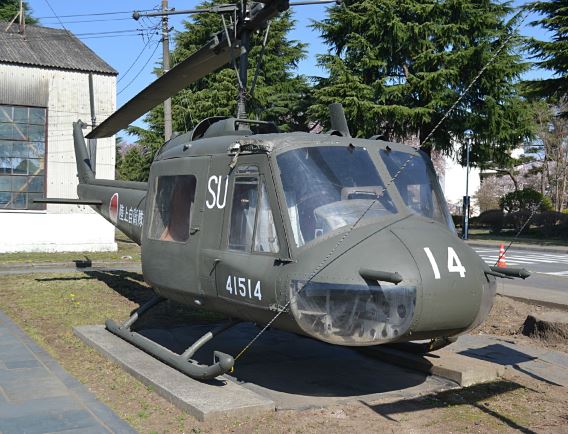 Delivered to the JGSDF on September 28, 1965, UH-1B 41514 was withdrawn from use on
Delivered to the JGSDF on September 28, 1965, UH-1B 41514 was withdrawn from use on
September 24, 1985, four days short of its 20th anniversary. The aircraft is a long-term
display resident at Camp Utsunomiya, Tochigi Prefecture.
(Photo [April 2017]: Warren Hardcastle)
 Shinodayama Army Camp at Izumo, Osaka Prefecture, still looks after this UH-1B. On active
Shinodayama Army Camp at Izumo, Osaka Prefecture, still looks after this UH-1B. On active
servce from August 1970 to May 1988, 41559 has been on display here since at least the
late 1990s and appears to have been treated to a recent fresh coat of paint.
(Photo [April 2016]: Hunini via Wikimedia Commons)
Fuji-Bell UH-1B (Part 2/2) |
|
| Serial | Last Known Location |
| 41560 | In storage hangar at Tokorozawa Aviation Museum, Saitama Prefecture (Current, photos on dedicated museum page [link] and from Oct. 2014 [link]) |
| 41571 | Kita-Utsunomiya Army Camp, Tochigi Prefecture (May 2018 [link]) |
| 41575 | Akita Army Camp, Akita Prefecture (Believed still present Apr. 2020) |
| 41576 | Abandoned rotorless at Sendai Army Camp, Kagoshima Prefecture (Apr.2020) |
| “41581” | (See 41531) |
| 41583 | JGSDF Obihiro Army Camp, Hokkaido Prefecture (moved from Bihoro Air Park, Bihoro, Abashiri District, Hokkaido Prefecture, in Dec. 2016) |
| 41585 | Shinto Furusato Park, 1920-1 Yamakoda, Shintomura, Kitagunma District, Gunma Prefecture 370-3502 (Jan. 2010 [link], present Feb. 2019) |
| 41586 | Fukushima Army Camp, Fukushima Prefecture (possibly removed 2019) |
| 41589 | Hakodate Army Camp, Hokkaido Prefecture (believed current, photo from Aug. 2015 [link]) |
| 41590 | Kushiro Army Camp, Hokkaido Prefecture (current July 2018, photo from Aug. 2016 [link]) |
| Last updated: Feb. 22, 2024 | |
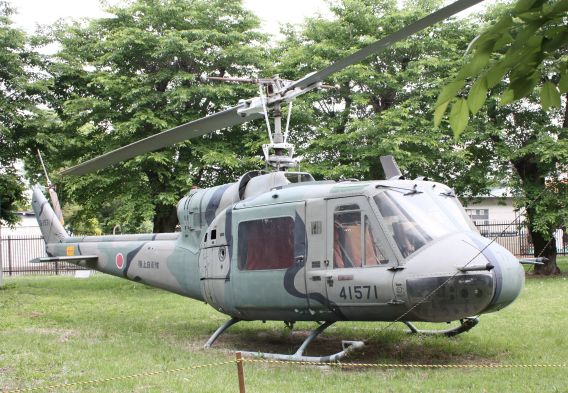 Heavily influenced by U.S. operations in Vietnam, the JGSDF operated a total of 90 UH-1B
Heavily influenced by U.S. operations in Vietnam, the JGSDF operated a total of 90 UH-1B
helicopters. The type was given the unofficial name Hiyodori (Bulbul).
 A long-standing resident at the Bihoro Air Park in Hokkaido Prefecture, as shown
A long-standing resident at the Bihoro Air Park in Hokkaido Prefecture, as shown
here in August 2009, UH-1B 41583 was among those aircraft moved to
JGSDF Obihiro Army Camp in December 2016.
(Photo: ‘100 yen’ via Wikimedia Commons)
 The UH-1B displayed in the Shinto Furusato Park, Shintomura, Gunma Prefecture.
The UH-1B displayed in the Shinto Furusato Park, Shintomura, Gunma Prefecture.
(Photo [March 2021] from the We Love Gunma tourism promotion website [link])
Fuji-Bell UH-1H (Part 1/5) |
|
| Serial | Last Known Location |
| 41606 | Front fuselage used for indoor training purposes (with 41644) at Narashino Army Camp, Narashino, Chiba Prefecture |
| 41610 | Nerima Army Camp, Tokyo (Apr. 2018 [link]) |
| 41613 | Maegawara Army Camp, Kurume, Fukuoka Prefecture |
| 41619 | Kushiro Army Camp, Hokkaido Prefecture (current July 2018, but in sorry state alongside UH-1B 41590 in photo from Aug. 2016 [link]) |
| (41620) |
Herb World Akita, 490-5 Shinmichishita, Numata, Nishimemachi, |
| 41621 | Uchihara Health Park, Mito City Hall Uchihara Branch Office, Mito, Ibaraki Prefecture (next to fire station, illuminated at night) (July 2019 [link]) |
| 41623 |
Training use at Kasugai Army Camp, Kasugai, Aichi Prefecture |
| 41625 |
Matsumoto Army Camp, Nagano Prefecture (Apr. 2019) |
| 41626 |
Training use (with 41627) at Katsuta Army Camp, Hitachinaka, Ibaraki Prefecture |
| 41627 |
Training use (with 41626) at Katsuta Army Camp, Hitachinaka, Ibaraki Prefecture |
| 41628 |
Ebino Army Camp, Ebino, Miyazaki Prefecture (May 2017 [link]) |
| 41631 |
Training use at Okubo Army Camp, Uji, Kyoto Prefecture |
| 41635 |
Ainoura Army Camp, Sasebo, Nagasaki Prefecture, with 41661 (Aug. 2019 [link]) |
| 41637 |
Main gate at Kita-Utsunomiya Army Camp, Tochigi Prefecture (June 2019 [link]) |
| 41638 | Training use at Kaita Army Camp, Kaita, Hiroshima Prefecture |
| 41640 | Instructional airframe at Narita Aeronautics College, 1842 Toride-Nishino, Toride City, Ibaraki Prefecture 302-0004 (possibly no longer present) |
| 41643 | Training use at Kawanishi Army Camp, Hyogo Prefecture |
| 41644 | Front fuselage (with doors from 41721) used for indoor training purposes at Narashino Army Camp, Narashino, Chiba Prefecture |
| 41645 | Training use at Mishuku Army Camp, Setagaya, Tokyo (Aug. 2017 [link]) |
| 41646 | Kita-Kumamoto Army Camp, Kumamoto Prefecture (Apr. 2019 [link]) |
| 41648 | (Cockpit doors from scrapped 41609) Ogawa Marine Center, 269-1 Noda, Omitama, Ibaraki Prefecture 311-3411 (Aug. 2019 [link]) |
| 41649 |
Fukuchiyama Army Camp, Fukuchiyama, Kyoto Prefecture (Photo from Dec. 2017 [link] still present Nov. 2019) |
| Last updated: Feb. 21, 2024 / Continued in Part 2 below | |
| Note: As of late 2023, there were reportedly nine unidentified UH-1Hs present for display/training purposes at JGSDF bases: Aomori: Hirosaki (with 41692); Fukuoka: Iizuka; Hokkaido: Betsukai, Higashi-Chitose (three aircraft); Nagasaki: Ainoura (in addition to 41635 and 41661); Shimane: Izumo; and Shizuoka: Higashi-Fuji Training Area |
|
 This 1977-vintage UH-1H (41648) had arrived at what was then the B&G (Blue Sea & Green Land)
This 1977-vintage UH-1H (41648) had arrived at what was then the B&G (Blue Sea & Green Land)
Foundation Ogawa Marine Center by 2002. Remaining when the swimming pool facility passed
to municipal management in 2006, the aircraft had its main rotors disassembled before being
moved to one side while the center underwent renovation in 2018. Although some took this
to be an indication of its imminent demise, the aircraft was still present in February 2020.
(Photo [Dec. 2018]: foxfoto via Twitter @Fox_now)
 Matsumoto Army Camp, April 2019 (Photo: コタツvia Twitter @shuka_iizo)
Matsumoto Army Camp, April 2019 (Photo: コタツvia Twitter @shuka_iizo)
 Northern Army troops adhere to social distancing rules as they practice manhandling an anonymous
Northern Army troops adhere to social distancing rules as they practice manhandling an anonymous
retired UH-1H during a four-day field training exercise held at Okadama and a training ground
in late May 2020. (Photo: JGSDF Northern Army via Twitter @NorthernArmy_pr)
Fuji-Bell UH-1H (Part 2/5) |
|
| Serial | Last Known Location |
| 41651 | Japan Defense Ministry, Ichigaya, Tokyo (See Location Report 7) |
| 41652 |
Kokubu Army Camp, Kirishima, Kagoshima Prefecture (Feb. 2019 [link]) |
| 41653 | Horobetsu Army Camp, Noboribetsu, Hokkaido Prefecture (July 2019) |
| 41654 | Training use at Utsunomiya Army Camp, Tochigi Prefecture |
| 41656 | Kanazawa Army Camp, Kanazawa, Ishikawa Prefecture (Apr. 2017 [link]) |
| 41657 |
Beppu Army Camp, Oita Prefecture |
| 41658 |
Makomanai Army Camp, Sapporo, Hokkaido Prefecture (Nov. 2023 [link]) |
| 41659 |
Uji Army Camp, Uji, Kyoto Prefecture |
| 41661 | Ainoura Army Camp, Sasebo, Nagasaki Prefecture (with 41635) |
| 41662 | Hachinohe Army Camp, Aomori Prefecture, with 41718 (Jan. 2017 [link]) |
| 41663 | Shinmachi Army Camp, Takasaki, Gunma Prefecture (photos from Apr. 2014 [link] and Oct. 2018 [link]; 41698 also present for training purposes) |
| 41665 | Kawasaki Heavy Industries Seishin Works, Kobe, Hyogo Prefecture |
| 41666 |
Miya River Watarai Park, 1260 Ohnogi, Watarai, Watarai District, |
| 41669 |
Mitsu Seiki Co., Ltd., 301 Shimogawai, Awaji, Hyogo Prefecture 656-1522 (Photo from Aug. 2016 [link]) |
| Last updated: Feb. 21, 2024 / Continued in Part 3 below | |
 The resident UH-1H (41656) among the cherry blossoms at Kanazawa Army Camp in April 2020.
The resident UH-1H (41656) among the cherry blossoms at Kanazawa Army Camp in April 2020.
Repainted in the darker three-tone temperate region camouflage scheme, the aircraft featured in
a December 2020 Twitter report by the Toyama SDF Provincial Cooperation Office following
an air experience flight arranged at the base for lottery-winning members of the public.
(Photo: 枕元の天使 via Twitter @knight306sq)
 Uji Army Camp remained home to UH-1H 41659 in April 2019.
Uji Army Camp remained home to UH-1H 41659 in April 2019.
(Photo: ナガレ☆ぼしvia Twitter @ryuseinoyoru)
 (Above and below) Another UH-1H to be found in natural surroundings, this one (41666)
(Above and below) Another UH-1H to be found in natural surroundings, this one (41666)
inhabits the Miya River Watarai Park in Mie Prefecture.
 (Photos: [Top, Mar. 2018] WANI via Twitter @wanikon428;
(Photos: [Top, Mar. 2018] WANI via Twitter @wanikon428;
[above, June 2021] むいむい via Twitter @R1ffP1w1aX1b7BA))
Fuji-Bell UH-1H (Part 3/5) |
|
| Serial | Last Known Location |
| 41672 |
JGSDF Public Information Center, 4-6 Sakaecho, Asaka, |
| 41676 | Training use at Yonago Army Camp, Tottori Prefecture (photos from Oct. 2017 [link] and Oct. 2019 [link]) |
| 41678 | Training use at Kita-Kumamato Army Camp, Kumamoto Prefecture |
| 41679 | Rotorless training airframe at Kasugai Army Camp, Kasugai, Aichi Prefecture |
| 41681 | Training use at Kita-Utsunomiya Aviation School, Tochigi Prefecture (Photos from May 2013 [link] and May 2018 [link]) |
| 41682 | Instructional airframe at Shinodayama Army Camp, Izumi, Osaka Prefecture (Believed still present, photo of cockpit from Apr. 2017 [link]; 41696 also used for training) |
| 41683 | Zentsuji Army Camp, Zentsuji, Kagawa Prefecture |
| 41684 | Rotorless training airframe at Matsudo Army Camp, Chiba Prefecture (Oct. 2020 [link]) |
| 41685 | Kasumigaura Army Camp Public Information Center, Ibaraki Prefecture |
| 41689 | Rotorless training airframe at Itazuma Army Camp, Gotemba, Shizuoka Prefecture (Dec. 2020) |
| Last updated: Jan. 7, 2022 / Continued in Part 4 below | |
 Squeezed in next to a pair of self-propelled howitzers, this example of a UH-1H (41672) can be
Squeezed in next to a pair of self-propelled howitzers, this example of a UH-1H (41672) can be
seen at the JGSDF Public Information Center at Asaka, Saitama Prefecture.
 Formerly operated by the Northern Army Helicopter Squadron from Okadama, Sapporo,
Formerly operated by the Northern Army Helicopter Squadron from Okadama, Sapporo,
41676 has been at Yonago Army Camp adjacent to JASDF Miho AB since at least 2003.
(Photo [Oct. 2014]: Andy Binks)
 Shinodayama Army Camp’s resident UH-1H 41682
Shinodayama Army Camp’s resident UH-1H 41682
(Photo [April 2016]: Hunini via Wikimedia Commons)
 Seen here on its spot at Zentsuji Army Camp, Kagawa Prefecture, in September 2010, UH-1H
Seen here on its spot at Zentsuji Army Camp, Kagawa Prefecture, in September 2010, UH-1H
41683 had replaced UH-1B 41522. Although in this October 2019 photo [link] next to a sign
that wrongly states that the aircraft is a UH-1J, what is presumably the same aircraft seems
to have had a new coat of camouflage. (Photo: 663highland via Wikimedia Commons)
 A long-term resident at the Kasumigaura Army Camp Public Information Center,
A long-term resident at the Kasumigaura Army Camp Public Information Center,
UH-1H 41685 sports an unusual covering of snow, January 7, 2022, the day
the center re-opened for reservation-only visits after the year-end break.
(Photo: JGSDF Camp Kasumigaura via Twitter @ CampKasumigaura)
 UH-1H 41689 at its home at the Itazuma Army Camp barracks in Gotemba,
UH-1H 41689 at its home at the Itazuma Army Camp barracks in Gotemba,
Shizuoka Prefecture. (Photo [Nov. 2019]: Warren Hardcastle)
Fuji-Bell UH-1H (Part 4/5) |
|
| Serial | Last Known Location |
| 41690 |
Minus main rotor at Tokushima Army Camp. Tokushima Prefecture |
| 41692 | Hirosaki Army Camp, Hirosaki, Aomori Prefecture |
| 41693 | Rotorless instructional airframe at Kita-Utsunomiya Aviation School, Tochigi Prefecture (May 2019 [link]) |
| 41694 | Funaoka Army Camp, Shibata Town, Miyagi Prefecture |
| 41695 | Rotorless on raised structure for instructional purposes at Kita-Utsunomiya Aviation School, Tochigi Prefecture (Photos from May 2013 [link] June 2019 [link]) |
| 41696 | Training use at Shinodayama Army Camp, Izumi, Osaka Prefecture (also 41682 present, on display) |
| 41697 | Training use at Aomori Army Camp, Aomori Prefecture (2019) |
| 41698 | Training use at Shinmachi Army Camp, Takasaki, Gunma Prefecture (41663 also present on display) |
| 41699 |
Training use at Takikawa Army Camp, Hokkaido Prefecture |
| 41700 |
Fujisan Juku no Mori Park, Inno, Gotemba, Shizuoka Prefecture (As seen in this page’s header photo, photo from Apr. 2018 [link]) |
| 41701 | Training use at Otsu Army Camp, Shiga Prefecture (Nov. 2019) |
| 41703 | Kasuminome Army Camp, Miyagi Prefecture (Feb. 2014) |
| 41704 | Jinmachi Army Camp, Higashine, Yamagata Prefecture (Apr. 2014) (with 41719, plus 41710 as training airframe) |
| 41708 | Taiwa Army Camp, Kurokawa District, Miyagi Prefecture |
| Last updated: Feb. 21, 2024 / Continued in Part 5 below | |
 Manufactured in August 1988 and accepted into service later that year, UH-1H 41700 came to the
Manufactured in August 1988 and accepted into service later that year, UH-1H 41700 came to the
end of its service career when with the Tachikawa-based Eastern Region Army Aviation Group in
2009. Displayed at Tachikawa for a time from that October, the aircraft was placed in
Fujisan Juku no Mori Park by October the following year, 2010.
 (Photos: [Top, Nov. 2020] 小豆 (Adzuki) via Twitter @airi_foret;
(Photos: [Top, Nov. 2020] 小豆 (Adzuki) via Twitter @airi_foret;
[above, Aug. 2020] 樹空の森 via facility’s Twitter account @Jukuunomori)
 (Photo [41701, Otsu Army Camp, Shiga Prefecture, Nov. 2019]: Mike Jefferies)
(Photo [41701, Otsu Army Camp, Shiga Prefecture, Nov. 2019]: Mike Jefferies)
 Including UH-1H 41704, the aircraft preserved at Jinmachi Army Camp are surrounded
Including UH-1H 41704, the aircraft preserved at Jinmachi Army Camp are surrounded
by white picket fences. (Photo [April 2014]: ‘contri’ via Wikimedia Commons)
Fuji-Bell UH-1H (Part 5/5) |
|
| Serial | Last Known Location |
| 41710 | Training use at Jinmachi Army Camp, Higashine, Yamagata Prefecture (plus 41704 and 41719 on display) |
| 41711 | Training use at Kokura Army Camp, Kitakyushu, Fukuoka Prefecture (Sept. 2018 [link]) |
| 41712 | Makomanai Army Camp, Sapporo, Hokkaido Prefecture (June 2018 [link]) |
| 41714 | Instructional airframe at Tachikawa Army Camp, Tokyo (Nov. 2019 [link]) (See photo above, at start of Helicopter section) |
| 41715 |
Kochi Army Camp, Konan, Kochi Prefecture (Sept. 2017 [link]) |
| 41716 |
In front of Hirosaki University of Health & Welfare, Hirosaki, |
| 41717 |
Training use at Hisai Army Camp, Tsu, Mie Prefecture (Apr. 2016 [link]) |
| 41718 |
Training use at Hachinohe Army Camp, Aomori Prefecture |
| 41719 |
Jinmachi Army Camp, Higashine, Yamagata Prefecture |
| (41721) | Front fuselage only, used for indoor training purposes, Narashino Army Camp, Chiba Prefecture (photo from Apr. 2017 [link], but reportedly removed and doors fitted to 41644) |
| 41723 | Omiya Army Camp, Omiya, Saitama Prefecture (May 2017 [link]) |
| 41724 | Display aircraft at Omura Army Camp, Nagasaki Prefecture (Nov. 2019 [link]) |
| 41726 |
Training use at Rumoi Army Camp, Hokkaido Prefecture (Feb. 2018 [link]) |
| 41727 | (Last Hokkaido-based UH-1H to be retired, by May 2017) Training use at Okadama Army Camp (photo from Mar. 2019 [link]) |
| 41729 | Training use at Kusu Army Camp, Kusu, Oita Prefecture (Oct. 2017 [link]) |
| 41730 | Training use at Tagajo Army Camp, Miyagi Prefecture (May 2021 [link]) |
| 41731 | Training airframe at Fukushima Army Camp, Fukushima Prefecture (Oct. 2017 [link]) |
| 41732 |
On main gate at Kita-Utsunomiya Army Camp, Tochigi Prefecture |
| 41733 |
(Last aircraft built) Tachikawa Army Camp, Tokyo |
| Last updated: Feb. 21, 2024 | |
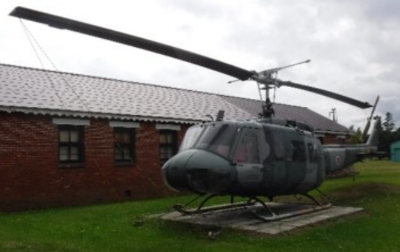 (Photo [41712, July 2020]: JGSDF Makomanai Public Relations via Twitter @CampMakomanaiPR)
(Photo [41712, July 2020]: JGSDF Makomanai Public Relations via Twitter @CampMakomanaiPR)
 The scene in December 2017, when the cocooned UH-1H 41716 is first put in place in front of the
The scene in December 2017, when the cocooned UH-1H 41716 is first put in place in front of the
Hirosaki University of Health & Welfare for training and publicity purposes. The banner
along the fuselage (below) reads Hirosaki University of Health & Welfare,
Faculty of Emergency Medical Science.
 Retaining a 1st Flight Eastern Army Helicopter Sqn badge on the cockpit door, the aircraft’s nose
Retaining a 1st Flight Eastern Army Helicopter Sqn badge on the cockpit door, the aircraft’s nose
is now emblazoned with the internationally recognized snake-and-staff (Rod of Ascelpius) emblem
of the medical profession, which (not visible here) is repeated on the rear side of the cabin.
The rear fuselage/tail boom sports the university logo and a Red Cross.
(Photos [top and above]: Hirosaki University of Health & Welfare Student PR Group
via Twitter @hirosakijggkg1)
 (Photo [41731, Fukushima Army Camp, Dec. 2019]: Mike Jefferies)
(Photo [41731, Fukushima Army Camp, Dec. 2019]: Mike Jefferies)
 Displayed near the Tachikawa base museum building in 2013, UH-1H 41709 served actively from
Displayed near the Tachikawa base museum building in 2013, UH-1H 41709 served actively from
1989 to 2011 but had been replaced by 2017.
Fuji-Bell UH-1J |
|
| Serial | Location |
| 41804 | JGSDF Kita-Utsunomiya Army Camp, Tochigi Prefecture |
| 41820 | JGSDF Imazu Army Camp, Takashima, Shiga Prefecture (Dec. 2022) |
| Last updated: Feb. 21, 2024 | |
According to Japan Ministry of Defense figures, no more than a handful of the 130 UH-1Js built have either been withdrawn from use of are in store. Although the first order for 12 was included in the 1989 budget, it was 1993 that the variant entered service, and the last batch of 16 formed part of the 2007 budget. Accidents at Tachikawa in June 2019 and Asahikawa in February 2020 would at the very least have seen the aircraft involved placed in store for spares (including these days ultimately for potential export) or relegated to instructional airframes.
It can be expected that the pace at which the 1990s veterans are pensioned off will be accelerated as UH-2 deliveries get under way.
 In December 2019, rotorless UH-1J 41804 was seen protected against the elements between the
In December 2019, rotorless UH-1J 41804 was seen protected against the elements between the
preserved aircraft at the Utsunomiya Army Camp main gate and those along its approach road.
(Photo: Mike Jefferies)
 The covers were removed to unveil UH-1J 41820 at Imazu Army Camp in early December 2022.
The covers were removed to unveil UH-1J 41820 at Imazu Army Camp in early December 2022.
(Photo: Masa via Twitter @Masa_akeno)
Hughes TH-55J |
|
| Serial | Last Known Location |
| 61307 |
Old Car Center KUDAN, Naraha, Futaba District, Fukushima |
(61313)* |
(Withdrawn from use as instructional airframe at Japan |
| 61314** |
Instructional airframe (with 61319) at Narita Aeronautics College, |
| 61319** |
(As 61314) |
| 61320 |
(As “JA7753”, which was formerly operated until 2006) |
| (61324)*** |
(Removed from indoor display at Ishikawa Aviation Plaza, |
| (61326) |
(Removed from Kasumigaura Army Camp Public Information |
| (61328) | (Removed from storage hangar at Tokorozawa Aviation Museum, Saitama Prefecture, and returned to JGSDF for disposal in 2020) (Photo from Oct. 2014 on dedicated museum page [link]) |
| 61331** |
Ainoura Army Camp, Sasebo, Nagasaki Prefecture |
| (61332)* |
(As 61313) |
| (61333)* |
(As 61313) |
| (61334)** |
Park at Kiraku Fureai no Oka, Tsukubamirai City, Ibaraki Prefecture |
| 61335** |
Replaced 61321 at Kita-Utsunomiya Army Camp, Tochigi |
| 61336** |
Hachinohe Army Camp, Aomori Prefecture |
| (61337)* |
(As 61313) |
| (61338)* |
(As 61313) |
|
* In 2017 or 2018, it was discovered that asbestos had been used in the manufacture |
|
| Last updated: May 13, 2021 | |
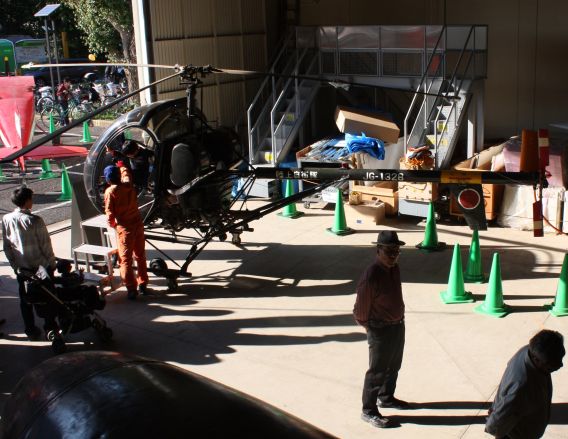 The JGSDF operated 38 TH-55Js in the training role 1972–1995. The stored Tokorozawa
The JGSDF operated 38 TH-55Js in the training role 1972–1995. The stored Tokorozawa
example usually only got to see the public light of day once a year but has now been
removed after the outbreak of “asbestos blight”.
 Ainoura Army Camp, Sasebo (Photo [undated]: うみみちvia Twitter @shimabarakko)
Ainoura Army Camp, Sasebo (Photo [undated]: うみみちvia Twitter @shimabarakko)
 As seen in the introductory photo of this helicopter section, this TH-55J has been a long-term
As seen in the introductory photo of this helicopter section, this TH-55J has been a long-term
resident at Hachinohe Army Camp but may have already been removed.
(Photo [August 2016]: eule_no via Twitter @eule-no)
JUST FOR THE RECORD

(Above and below) Seen in the hangar at Noto Airport are three of the five TH-55Js acquired by the
Japan Aviation Academy Wajima (JAAW). All had to be carefully scrapped due to the belated
discovery of the presence of asbestos. (Photo [Jan. 2014] courtesy Masayuki Sakamoto, JAAW)
 (Photo [Oct. 2015}: i北陸 [i-Hokuriku] / Hokuriku region official event and
(Photo [Oct. 2015}: i北陸 [i-Hokuriku] / Hokuriku region official event and
tourist destination blog [link])
 (Photo [Oct. 2015}: i北陸 [i-Hokuriku] / Hokuriku region official event and
(Photo [Oct. 2015}: i北陸 [i-Hokuriku] / Hokuriku region official event and
tourist destination blog [link])
 The writing already on the wall, some of the JAAW TH-55J fleet were allowed out at what would
The writing already on the wall, some of the JAAW TH-55J fleet were allowed out at what would
have been their last open day in October 2018. (Photo: i北陸 [i-Hokuriku] / Hokuriku region
official event and tourist destination blog [link])
Kawasaki-Bell H-13* |
|
| Serial | Last Known Location |
| 30003 |
(H-13E/Kawasaki-Bell 47D-1) In storage hangar at Tokorozawa Aviation Museum, Saitama Prefecture (photo on dedicated museum page [link]) |
| 30108 | (H-13H/Kawasaki-Bell 47G-2) Chic Chic Market, Nong Khai, Thailand (Nov. 2018) (Formerly at military surplus dealer in Jomtien, Thailand) See Bulletin Board story for Nov. 30, 2017 |
| 30120 | Behind netting in shed at local museum at 36-1 Shimizu, Kota, Nukata District, Aichi Prefecture (Aug. 2020) |
| 30124 | Dai-ichi Institute of Technology, Kirishima, Kagoshima Prefecture (Oct. 2019) |
| (30213) |
Tsudanuma Campus, College of Industrial Technology, Nihon University, |
| 30217 | (As “30216”) Old Car Center KUDAN, Naraha, Futaba District, Fukushima Prefecture (Sept. 2020 [link]) |
| 30219 | Instructional airframe at Narita Aeronautics College, Toride City, Ibaraki Prefecture (likely already scrapped) |
| * All H-13KH (Kawasaki-Bell 47G3B-KH4) unless otherwise stated. | |
| Last updated: June 19, 2022 | |
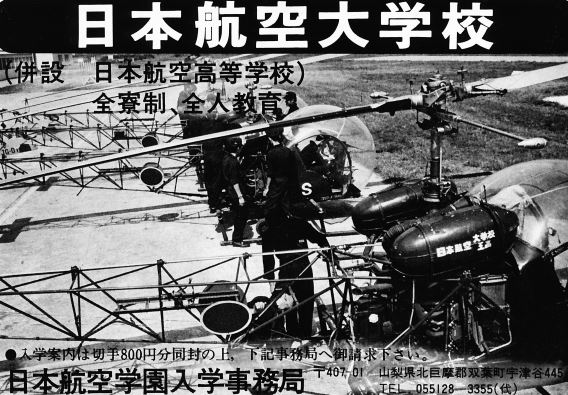 Appearing in the August 1981 edition of the now defunct magazine Air World, this ad for the Japan
Appearing in the August 1981 edition of the now defunct magazine Air World, this ad for the Japan
Aviation Academy shows the small fleet of former-JGSDF H-13 helicopters that were at that time
used by the organization. The ad requests that any prospective new student send in a stamped,
self-addressed envelope to the value of 800 yen to the high school campus in Futaba (now
part of the city of Kai), Yamanashi Prefecture, to receive an admission information pack.
 Another former NSF aircraft, H-13E 30003 was still present in the
Another former NSF aircraft, H-13E 30003 was still present in the
Tokorozawa storage hangar in October 2013.
 Until its removal on February 19, 2021, 30213 was at the Tsudanuma Campus of Nihon University’s
Until its removal on February 19, 2021, 30213 was at the Tsudanuma Campus of Nihon University’s
College of Industrial Technology. The same contractor also removed OH-6D 31230 that day.
(Photo [undated]: Chiba SDF Provincial Cooperation Office website [link] accessed Dec. 27, 2020)
 Another view of the impostor H-13KH “30216” shown at the start of this helicopter section.
Another view of the impostor H-13KH “30216” shown at the start of this helicopter section.
(Photo [Old Car Center KUDAN, Naraha, Dec. 2019]: Warren Hardcastle)
 The former JGSDF 30108 now on display at the Chic Chic Market in Nong Khai, northeastern
The former JGSDF 30108 now on display at the Chic Chic Market in Nong Khai, northeastern
Thailand. The aircraft has been painted to resemble a U.S. Army Bell H-13 from M*A*S*H,
the popular TV comedy-drama series from the 70s/early 80s set during the Korean War.
(Also present at this location, in JGSDF markings, is a strange ex-Thai T-41/O-1 composite.)
(Photo [November 2018]: Alec Wilson)
Kawasaki-Boeing CH-47J Chinook |
|
| Serial | Last Known Location |
| 52901 | Stored at Asaka Army Camp, Saitama Prefecture (June 2013 [link]) |
| 52904 | Training use minus rotors at Narashino Army Camp, Chiba Prefecture (Apr. 2017 [link]) |
| 52905 | Rotorless at Higashi-Fuji Training Ground, Shizuoka Prefecture (Sept. 2017 [link]) |
| 52907 | Training use at Utsunomiya Army Camp, Tochigi Prefecture |
| 52909 |
(Used during Fukushima nuclear plant operations in 2011) |
| Last updated: Feb. 25, 2024 | |
 Matsumoto Army Camp CH-47J, April 2018
Matsumoto Army Camp CH-47J, April 2018
(Photo: すてんがん工@新製品開発中廠 via Twitter @stengunfactory)
Kawasaki-Hughes OH-6D (Part 1/4) |
|
| Serial | Last Known Location |
| 31121 | Rotorless on raised structure for instructional purposes at JGSDF Kita-Utsunomiya Aviation School, Tochigi Prefecture (Apr. 2020, photo from May 2018 [link]) |
| 31122 |
On indoor display at Mitsu Seiki Co., Ltd., 301 Shimogawai, Awaji, Hyogo Prefecture 656-1522 (current) (See Feb. 18, 2014, report on Aviation Museums page) |
| 31124 | JGSDF Kita-Utsunomiya Aviation School, Tochigi Prefecture (Apr. 2020, photo from May 2018 [link]) |
| 31126 | Instructional airframe at Kisarazu Army Camp, Chiba Prefecture (Dec. 2019 [link]) |
| 31127 | Funaoka Army Camp, Shibata Town, Miyagi Prefecture (Apr. 2020) |
| 31129 | Kawasaki Heavy Industries Seishin Works, 8-2 Takatsudai 2-Chome, Nishi-ku, Kobe, Hyogo Prefecture 651-2271 (Apr. 2020) |
| 31132 | JGSDF Kita-Kumamoto Army Camp (Apr. 2020, photo from Apr. 2019 [link]) |
| 31133 |
In front of main entrance within grounds of Oji Technical High School, (Mar. 2021) |
| 31134 | Hirosaki Army Camp, Hirosaki, Aomori Prefecture |
| 31135 | On hard-standings, JGSDF Kita-Utsunomiya Aviation School, Tochigi Prefecture (Apr. 2020, photo from June 2019 [link]) |
| 31136 | (Tailboom from 31186) Taiwa Army Camp, Kurokawa District, Miyagi Prefecture (Apr. 2020, photo from June 2016 [link]) |
| 31138 | Kasuminome Army Camp, Miyagi Prefecture [link] (Apr. 2020), [link] (Aug. 2022) |
| (31139) |
Kamishihi Ninki no Sato Park, Eiheiji, Fukui Prefecture (Apr. 2020) (Now removed, see below) |
| 31141 | To one side of gate guard area at JGSDF Kita-Utsunomiya Aviation School, Tochigi Prefecture, presumably awaiting disposal, Apr. 2020 (May 2018 [link]) |
| 31144 | (Tailboom from 31193) On roof of construction company building (Apr. 2020) 44 Takaya, Naka Ward, Kurashiki, Okayama Prefecture 703-8233 |
| 31146 | Koriyama Army Camp, Fukushima Prefecture (Apr. 2020) |
| 31147 | Tokushima Army Camp, Tokushima Prefecture (Apr. 2020) |
| 31148 | Shinodayama Army Camp, Izumi, Osaka Prefecture (Apr. 2020) |
| 31149 | Yonago Army Camp, Tottori Prefecture (Mar. 2020 [link]) |
| Last updated: Feb. 23, 2024 / Continued in Part 2 below | |
 The ravages of time have taken their toll on this 1980-vintage, ex-9th AvSqn OH-6D, which was
The ravages of time have taken their toll on this 1980-vintage, ex-9th AvSqn OH-6D, which was
placed in its then pristine location at the Oji Technical High School in Nara in November 2003.
(Photo from Feb. 2004 [link]). Intended to inspire the school’s students, the vertically written
Japanese is the aircraft’s aspirational Dreams (Take) Flight name. The accompanying
caption stated that six graduates were joining the SDF that year.
(Photo [posted March 2021]: JSDF Nara Provincial Cooperation Office via Twitter @nara_pco)
 The Kawasaki-built OH-6D 31141 now resident at the Kita-Utsunomiya main gate was
The Kawasaki-built OH-6D 31141 now resident at the Kita-Utsunomiya main gate was
delivered to the JGSDF in February 1981.
 An anonymous OH-6D (actually 31149) at Yonago Army Camp, Oct. 2014 (Photo: Andy Binks)
An anonymous OH-6D (actually 31149) at Yonago Army Camp, Oct. 2014 (Photo: Andy Binks)
 (Photo [Nov. 2019]: Warren Hardcastle)
(Photo [Nov. 2019]: Warren Hardcastle)
Ninki no Sato Park in Eiheiji, Fukui Prefecture, is where 1981-vintage OH-6D 31139, which had ended its service career at the Kasumigaura Aviation School, had whiled away its days since July 2002. When the above photo was taken, in November 2019, the aircraft was in general need of attention; the front lower left-side cockpit glazing had remained broken since at least the preceding February. A photo accompanying an article on the Mainichi Shimbun website (dated Sept. 7, 2020) showed that first-aid had been crudely administered in the form of tape around the damaged glazing panel by August 2020. The headline, however, ominously stated “Reasons why helicopter is now to be removed”. For some possibly COVID-related reason, the removal was excessively delayed but had been carried out be the end of March 2022.
Kawasaki-Hughes OH-6D (Part 2/4) |
|
| Serial | Last Known Location |
| 31151 |
Japan Aviation High School, Utsuya, Kai, Yamanashi Prefecture (May 2022) |
| (31152) | (Tailboom from 31157) Rotor-less display airframe at JGSDF Kasumigaura Aviation School, Ibaraki Prefecture (Now removed) |
| 31153 | Shizuoka Institute of Science and Technology (SIST), Fukuroi, Shizuoka Prefecture (March 2016, replaced by 31225?) |
| 31156 | Sendai Army Camp, Miyagi Prefecture (Apr. 2020) |
| 31157 | Senzo Army Camp, Itami, Hyogo Prefecture (May 2017 [link], present Apr. 2020) |
| 31161 | Japan Aviation Academy Wajima (JAAW) Noto Airport Campus, 9-27-7 Sue, Mitsui, Wajima, Ishikawa Prefecture 929-2372 (Apr. 2016 [link]) |
| 31162 | Instructional airframe (with 31168) at College of Naka-Nippon Aviation, Seki, Gifu Prefecture (Nov. 2019) |
| 31163 | Chiba Institute of Science (CIS), Choshi, Chiba Prefecture (Photo follows Part 3 below) |
| 31164 | Izumo Army Camp, Izumo, Shimane Prefecture (Oct. 2023 [link]) |
| 31168 | Instructional airframe (with 31162) at College of Naka-Nippon Aviation, Seki, Gifu Prefecture (Nov. 2019) |
| 31172 |
Instructional airframe at Tachikawa Army Camp, Nov. 2019 |
31173 |
Instructional airframe at Tachikawa Army Camp, Tokyo (Nov. 2013) On display near base museum (photo from Sept. 2018 [link]) |
| 31175 |
Jinmachi Army Camp PR Center, Higashine, Yamagata Prefecture |
| 31178 | (Tailboom from 31201) Hachinohe Army Camp, Aomori Pref. (Apr. 2020) |
| 31179 | Iwate Army Camp, Takizawa, Iware Prefecture |
| 31180 | (Tailboom from 31174) Japan Aviation High School, Utsuya, Kai City, Yamanashi Prefecture (May 2022, photo from Oct. 2016 [link]) |
| 31181 | JGSDF Yamaguchi Army Camp (Apr. 2020, photo from Nov. 2018 [link]) |
| 31182 | Higashi-Tachikawa Army Camp, Tokyo (Apr. 2020) |
| 31183 | Officer Candidate School, Maegawara Army Camp, Kurume, Fukuoka Prefecture (Apr. 2020) |
| 31188 | (Tailboom from 31226) On grass verge display, minus main rotor blades, at JGSDF Kita-Utsunomiya Aviation School, Tochigi Prefecture (Apr. 2020, photo from May 2018 [link]) |
| Last updated: Feb. 25, 2024 / Continued in Part 3 below | |
 One of two rotor-less OH-6Ds that were mounted on platforms next to the tower at the Kasumigaura
One of two rotor-less OH-6Ds that were mounted on platforms next to the tower at the Kasumigaura
Aviation School. Their elevated positions enabled trainee pilots to get used to the line of sight from a
hovering helicopter. When OH-6 training ceased, the aircraft were used for display purposes only.
Both were removed in 2015, the other (31170) is now at the Misawa Aviation and Science Museum.
 Delivered in November 1982, this OH-6D was involved in an accident at the Toyohira training
Delivered in November 1982, this OH-6D was involved in an accident at the Toyohira training
ground in Sapporo on March 12, 1992. As a result, the aircraft was struck off active charge
and ended up on display near the Tachikawa Army Camp base museum.
The aircraft had been replaced by 2017.
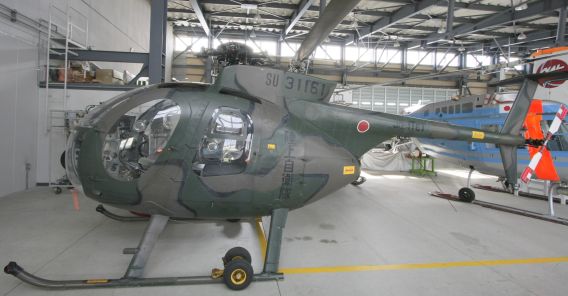 Lacking its main rotor, this OH-6D is now a permanent resident in the hangar at
Lacking its main rotor, this OH-6D is now a permanent resident in the hangar at
Japan Aviation Academy Wajima’s Noto Airport Campus.
(Taken in January 2014, photo courtesy Masayuki Sakamoto, JAAW)
 OH-6Ds 31162 and 31168 were delivered to the JGSDF in October 1983 and February 1985,
OH-6Ds 31162 and 31168 were delivered to the JGSDF in October 1983 and February 1985,
respectively. Long since unable to move under their own power, they have been mounted on
trolleys for ground handling training at Nakanippon Aviation College for
more than a decade. (Photo [Nov. 2019]: Warren Hardcastle)
 (Photo [undated]: Jinmachi Army Camp PR Center website ([link], accessed Feb. 2024)
(Photo [undated]: Jinmachi Army Camp PR Center website ([link], accessed Feb. 2024)
 Its original fuselage mated with the tail from another aircraft, this composite OH-6D was put out
Its original fuselage mated with the tail from another aircraft, this composite OH-6D was put out
to grass at Hachinohe Army Camp. (Photo [31178, Aug. 2016]: eule_no via Twitter @eule-no)
Kawasaki-Hughes OH-6D (Part 3/4) |
|
| Serial | Last Known Location |
| 31193 | (Tailboom from 31221) On grass verge display, still with rotor blades, at JGSDF Kita-Utsunomiya Aviation School, Tochigi Prefecture (Apr. 2020, photo from May 2018 [link]) |
| 31195 | (Tailboom from 31218) Inside fenced enclosure in park within Kiryugaoka amusement park, Miyamotomachi 4-1-1, Kiryu, Gunma Prefecture (Apr. 2020) |
| 31197 | (Tailboom from 31214) Kanazawa Institute of Technology, 7-1 Ogigaoka, Nonoichi, Ishikawa Prefecture 921-8501 (installed May 2012) (Mar. 2020 [link]) |
| 31200 | Kochi Army Camp, Kochi Prefecture (Apr. 2013) |
| 31201 | Aozora (Blue Sky) Nursery School, Tomisato, Chiba Prefecture (Apr. 2020) |
| 31203 | Kasuminome Army Camp (Apr. 2019, photo from Apr. 2016 [link]) |
| 31204 | East Japan Air Technical School, Sendai, Miyagi Prefecture (Dec. 2019) |
| (31211) |
Maruoka Park, 3201 Yokogawacho, Kamino, Kirishima, Kagoshima Prefecture |
| 31214 |
Outside Yoshimatsu Sports Hall, Yusui, Kagoshima Prefecture (Oct. 2019) |
| 31219 |
Omiya Army Camp, Saitama City, Saitama Prefecture |
| 31225 |
Shizuoka Institute of Science and Technology (SIST), Fukuroi, Shizuoka Prefecture |
| (31230) |
(Tail from 31267) In playground of Misakikobato Nursery School, |
| 31241 | Camp Utsunomiya, Tochigi Prefecture (June 2019, photo from June 2016 [link]) |
| 31245 | (Tail from 31273) Piso Tenjin Nursing Care Centre, Shishikura, Kasumigaura, Ibaraki Prefecture (Apr. 2020) |
| 31246 | Kokubu Army Camp, Kirishima, Kagoshima Prefecture (Apr. 2020) |
| 31247 | Takayubaru Sub Army Camp, Mashiki, Kumamoto Prefecture |
| 31251 |
Kokura Army Camp, Kitakyushu, Fukuoka Prefecture (Apr. 2020, photo from Sept. 2018 [link]) |
| 31261 | Hokuryo High School, Saga City, Saga Prefecture Open-ended loan commenced Sept. 2017, featured in 2024 promo video (link) |
| 31262 | Obihiro Army Camp, Hokkaido Prefecture |
| (31265) | Kasumigaura Army Camp Public Information Center, Ibaraki Prefecture (May 2018) Replaced 31212, had itself replaced by 31311 by Oct. 2021 (See May 18, 2014, report on Aviation Museums page) |
| Last updated: Feb. 23, 2024 / Continued in Part 4 below | |
 Two photos of OH-6Ds loaned to educational establishments at opposite ends of Japan’s
Two photos of OH-6Ds loaned to educational establishments at opposite ends of Japan’s
educational system in Chiba Prefecture. (Above) 31230 at the playground of the
Misakikobato Nursery School in Funabashi, which was removed in February
2021, and (below) 31163 at the Chiba Institute of Science (CIS) in Choshi. (Photos [undated]: Chiba SDF Provincial Cooperation Office website [link] accessed Dec. 27, 2020)
(Photos [undated]: Chiba SDF Provincial Cooperation Office website [link] accessed Dec. 27, 2020)
 As is often the case with OH-6Ds, the example at the Kanazawa Institute of Technology is a mixture,
As is often the case with OH-6Ds, the example at the Kanazawa Institute of Technology is a mixture,
comprising mainly 31197 with the tail boom from 31214. (Photo [Nov. 2019]: Warren Hardcastle)
 Doctor-Heli emergency medical service helicopters are often seen flying over the Aozora (Blue Sky)
Doctor-Heli emergency medical service helicopters are often seen flying over the Aozora (Blue Sky)
Nursery School that opened in Tomisato, Chiba Prefecture, on April 1, 2011. A former SDF member
involved with the management of the school, which is also close to Narita International Airport,
thought it would be aspirational for the pupils to have a real helicopter on site. So a request
was submitted and in due course the school rewarded by the presentation of 1988-vintage
OH-6D 31201 previously operated at the JGSDF Aviation School at
Akeno, Mie Prefecture. (Photo [April 2017]: Warren Hardcastle)
 Having also gone on to a second career as a training aid with a civilian organization, OH-6D
Having also gone on to a second career as a training aid with a civilian organization, OH-6D
31204 was at the East Japan Air Technical School (EJAIR) in Sendai in December 2019.
(Photo: Warren Hardcastle)
 Flown by the Sky Hornets display team in 2012, 31241 had been placed on display at Camp
Flown by the Sky Hornets display team in 2012, 31241 had been placed on display at Camp
Utsunomiya, Tochigi Prefecture, by April 2014. (Photo [April 2017]: Warren Hardcastle)
Kawasaki-Hughes OH-6D (Part 4/4) |
|
| Serial | Last Known Location |
| 31270 | Misawa Aviation & Science Museum, Misawa, Aomori Prefecture (formerly on platform at Kasumigaura, replaced 31184 June 2015, Oct. 2020 [link]) |
| 31276 | Higashi-Chitose Army Camp, Hokkaido Prefecture (April 2020) |
| 31280 | Soumagahara Army Camp, Gunma Prefecture (Apr. 2019) |
| 31286 | In snow camouflage in hangar at Kasumigaura (May 2017) |
| 31289 | Installed close to main gate at JGSDF Hisai Army Camp, Tsu, Mie Prefecture, Nov. 2020 |
| 31293 | Kasumigaura* (March 2020) |
| 31294 | Instructional airframe at Okadama (July 2022) |
| 31296 | Kasumigaura (March 2020) |
| 31297 | Kasumigaura (March 2020) |
| 31298 | Kasumigaura (last flight with 102nd Sqn at Kisarazu, January 2020) |
| 31299 to 31304 | Kasumigaura (March 2020) |
| 31305 | Kasumigaura (last flight with 102nd Sqn at Kisarazu, March 2020) |
| 31306 | (Last flew with 13th AvSqn at Hofu, March 2020) Obihiro Army Camp, Hokkaido Prefecture |
| 31307 | Kasumigaura (last flight with 4th AvSqn at Metabaru, March 2020) |
| 31308 | Kasumigaura (last flight with 10th AvSqn at Akeno, March 2020) |
| 31309 | Kasumigaura (March 2020) |
| 31310 | Kasumigaura (last flight with 4th AvSqn at Metabaru, March 2020) Cabin section on display at JGSDF Itami PR centre, Hyogo Prefecture, Apr. 2023 |
| 31311 | Kasumigaura (made last JGSDF OH-6D flight, from Tachikawa, Mar. 25, 2020) Had replaced 31265 at Kasumigaura Army Camp Public Information Center by Oct. 2021 |
| 31312 | Kasumigaura (last flight with 10th AvSqn at Akeno, March 2020) Shibata Army Camp, Niigata Prefecture (Jan. 2022 [link]) |
| 31313 | JASDF Hofu-Kita, Yamaguchi Prefecture (June 2023 [link]) |
| * In the run-up to the OH-6D’s withdrawal from service at the end of March 2020, Kasumigaura Army Camp served its usual role as a collection point for retired airframes. |
|
| Last updated: Feb. 23, 2024 | |
 With the help of a truck-mounted crane, newly arrived OH-6D 31289 is carefully lowered into
With the help of a truck-mounted crane, newly arrived OH-6D 31289 is carefully lowered into
position close to the main gate at JGSDF Hisai Army Camp, Tsu, Mie Prefecture.
(Photo [Nov. 2020]: Asagumo News via Twitter @AsagumoNews52)
 Wheeled out for a base anniversary event at Okadama in July 2022, having been retained as an
Wheeled out for a base anniversary event at Okadama in July 2022, having been retained as an
instructional airframe, OH-6D 31294 was displayed in a colour scheme that harked back to the
base’s now long since defunct Northern Ladybirds display team. Used for SDF recruitment
purposes, the slogan carried as a ladybird’s thought and speech bubbles on either side of
the tail boom translates as “Protecting people. That’s rewarding.” The banner on the
aircraft’s left side, forward of the hinomaru, refers to the 100 years that have passed
since the former urban district of Sapporo Ward was granted city status. The AFM
on the rotor mast stands for the Northern Army’s Aircraft Field Maintenance unit.
 (Photos: [Top] Official髭曇dism via Twitter @foggy_ja8369;
(Photos: [Top] Official髭曇dism via Twitter @foggy_ja8369;
[above] スイトウさん via Twitter @suitou_san)
 The cabin section of 31310, one of the last OH-6Ds in operational service, was
The cabin section of 31310, one of the last OH-6Ds in operational service, was
placed in the PR centre at JGSDF Itami in April 2023.
(Photo [posted Oct. 2023]: Masa via X [formerly Twitter] @masa_akeno)
 Reportedly placed on display in July 2021, Shibata Army Camp’s OH-6D 31312 was used
Reportedly placed on display in July 2021, Shibata Army Camp’s OH-6D 31312 was used
for Christmas illuminations that year. (Photo: ましまし via X @mashiko1970)
 Around 60 12th Helicopter Unit personnel were present to bid farewell to 31313—the last of the 193
Around 60 12th Helicopter Unit personnel were present to bid farewell to 31313—the last of the 193
OH-6Ds built for the JGSDF—on its last flight, which was from the unit’s base at Soumagahara
to the OH-6D collection point at Kasumigaura Army Camp. (See photo below)
(Photo [Mar. 6, 2020]: JGSDF/12th Brigade Public Relations via Twitter)
 Still bearing the 12th Helicopter Unit identifier XIIH, OH-6D 31313 was
Still bearing the 12th Helicopter Unit identifier XIIH, OH-6D 31313 was
eventually found a home at JASDF Hofu-Kita AB.
(Photo [taken March 2021]: JASDF Hofu-Kita AB via Twitter @hofukitabase)
 Part of the used OH-6DJ lot at the JGSDF Kasumigaura central collection point, March 2020
Part of the used OH-6DJ lot at the JGSDF Kasumigaura central collection point, March 2020
(Photo [posted Oct. 2021]: べ via Twitter @6813_bk117)
Kawasaki-Hughes OH-6J (Part 1/2) |
|
| Serial | Last Known Location |
| (31009) | Nihonbara Army Camp, Okayama Prefecture (Oct. 2017) Since replaced by 31109 |
| 31016 |
In JMSDF colours 211:8761 at Old Car Center KUDAN, Naraha, Futaba District, |
| (31032) | Yonago Army Camp, Tottori Prefecture (removed by early 2017) |
| (31042) | Ebino Army Camp. Miyazaki Prefecture, replaced by 31091 |
| 31043 | JGSDF Betsukai Army Camp, Notsuke District, Hokkaido Prefecture (Note that some references give the location as “Bekkai”) (Photos from Aug. 2007 to Sept. 2018 [link]) |
| 31053 | Privately owned in Minobu Town, Minamikoma District, Yamanashi Prefecture (Current, appeared on Japanese TV programme, April 2016) |
| 31055 | Bihoro Army Camp, Bihoro, Hokkaido Prefecture (July 2023 [link]) |
| 31058 | Formerly used for testing bearingless rotor, on indoor display at Gifu- Kakamigahara Air and Space Museum, Gifu Prefecture (see also 31081) (Photo from Apr. 2018 on dedicated museum page [link]) |
| 31065 | On indoor display at Tokorozawa Aviation Museum, Saitama Prefecture (Photos on dedicated museum page [link] and from Dec. 2020 [link]) |
| (31075) | Instructional airframe at Narita-Tsukuba Aviation College, 1842 Toride-Nishino, Toride City, Ibaraki Prefecture 302-0004 (removed 2023) |
| 31081 | Forms part of helicopter flight experience exhibit at Gifu-Kakamigahara Air and Space Museum, Gifu Prefecture (Apr. 2018 visit [link]) (Photo taken at the then Kakamigahara Aerospace Science Museum Feb. 2013 [link]) |
| (31084) | Nagano City Youth Science Center, Shiroyama Park, Nagano Prefecture (Facility closed in March 2022) |
| 31088 | On raised structure outside Nagasaki branch office of Kyushu Defense Bureau, 2-25 Dejima-machi, Nagasaki, Nagasaki Prefecture 850-0862 (Oct. 2020 [link]) |
| 31089 | Sangenya Army Camp, Okayama, Okayama Prefecture (Oct. 2018 [link]) |
| Last updated: Feb. 22, 2024 / Continued in Part 2 below | |
 Still artificially aloft, Tokorozawa Aviation Museum’s OH-6J 31065 ended its 15-year
Still artificially aloft, Tokorozawa Aviation Museum’s OH-6J 31065 ended its 15-year
military service career in February 1989.
 One of the very first OH-6Js to enter service with the JGSDF, 31009 was handed over on
One of the very first OH-6Js to enter service with the JGSDF, 31009 was handed over on
March 9, 1969, and remained in service until July 28, 1986. The aircraft was resident
at Nihonbara Army Camp, Okayama Prefecture, from at least the late 1990s until
replaced circa 2018. (Photo [October 2017]: Hunini via Wikimedia Commons)
 Having acquired ex-JGSDF OH-6J 31016, the management at the Old Car Center in Naraha
Having acquired ex-JGSDF OH-6J 31016, the management at the Old Car Center in Naraha
decided to repaint the aircraft as 8761, which in March 1973 had been the first aircraft of this
type to enter service with the JMSDF.
(Photo [Old Car Center KUDAN, Naraha, Dec. 2019]: Warren Hardcastle)
 OH-6J 31053 forms part of a private collection in a bucolic setting in Yamanashi Prefecture.
OH-6J 31053 forms part of a private collection in a bucolic setting in Yamanashi Prefecture.
(Photo [Aug. 2020]: TAKA via Twitter @alice_herb, who uploaded other images of the
collection and a short video of their location here [link])
 The OH-6J linked to a hands-on flight experience exhibit in the since early 2018 tenebrous
The OH-6J linked to a hands-on flight experience exhibit in the since early 2018 tenebrous
zone of the Gifu-Kakamigahara Air and Space Museum.
(Photo [Mar. 2019]: Alan Wilson via Wikimedia Commons)
Kawasaki-Hughes OH-6J (Part 2/2) |
|
| Serial | Last Known Location |
| 31091 | Replaced 31042 at Ebino Army Camp, Miyazaki Prefecture (May 2017 [link]) |
| 31093 | On indoor display at Ishikawa Aviation Plaza, Komatsu Airport, Ishikawa Prefecture (Nov. 2020 [link]) |
| 31094 | Higashi Nihon Technical School, Sendai AP, Miyagi Prefecture (current?) |
| (31096) | Instructional airframe at Department of Aeronautical Engineering, Dai-ichi Institute of Technology, Kirishima, Kagoshima Prefecture (Removed June 2021) |
| 31103 | Displayed inside hangar at Department of Aerospace Engineering, Nippon Bunri University, Oita, Oita Prefecture (Oct. 2018 [link]) |
| 31104 | Ainoura Army Camp, Sasebo, Nagasaki Prefecture (current) (See photo on this page, at start of Helicopters section) |
| 31109 | Replaced 31009 at Nihonbara Army Camp, Okayama Prefecture |
| 31110 | Zentsuji Army Camp, Zentsuji, Kagawa Prefecture (Current, Oct. 2019 photo with wrong [OH-6D] sign deleted) |
| 31111 | Higashi-Chitose Army Camp, Hokkaido Prefecture (Believed current Apr. 2020, photo from Apr. 2016 [link]) |
| 31115 |
Kita-Utsunomiya Army Camp, Tochigi Prefecture (June 2019 [link]) |
| Last updated: Feb. 22, 2024 | |
 Still bearing the markings of Hofu-based 13th Squadron, this OH-6J was delivered on February 17,
Still bearing the markings of Hofu-based 13th Squadron, this OH-6J was delivered on February 17,
1977, and withdrawn from use on June 30, 1995. The aircraft reportedly came into the possession
of current owner, Nippon Bunri University in Oita, the following year.
(Photo [April 2017]: Warren Hardcastle)
 Providing a comparison with the more recent linked image provided in the listing, this photo shows
Providing a comparison with the more recent linked image provided in the listing, this photo shows
OH-6J 31110 at Zentsuji in September 2010. (Photo: 663highland via Wikimedia Commons)
 Handed over to the JGSDF in February 1976, the former Tachikawa base collection OH-6J
Handed over to the JGSDF in February 1976, the former Tachikawa base collection OH-6J
31098 was operating with the 8th Sqn when retired from service in June 1995. Seen here in
November 2013, there was no sign of this aircraft in November 2017.
Kawasaki-Vertol KV-107II Variants (Part 1/2) |
|
| Serial | Last Known Location |
| 51701 | (KV-107II-4) Bihoro Army Camp, Abashiri District, Hokkaido Prefecture (with 51741; photos from July 2018 [link], July 2023 [link]) |
| 51703 | (KV-107II-4) Okadama Army Camp, Sapporo, Hokkaido Prefecture (Photos from July 2016 [link], Aug. 2018 [link])) |
| 51705 | (KV-107II-4) Ainoura Army Camp, Sasebo, Nagasaki Prefecture (Photos from Oct. 2014 [link]) |
| 51707 |
(KV-107II-4) Training use at Higashi-Chitose Army Camp, Hokkaido |
| 51711 |
(KV-107II-4) Kokubu Army Camp, Kirishima, Kagoshima Prefecture (Photo from Feb. 2019 [link]) |
| 51712 |
(KV-107II-4) Matsumoto Army Camp, Nagano Prefecture (Oct. 2022 [link]) |
| 51717 |
(KV-107II-4) Jinmachi Army Camp, Yamagata Prefecture |
| 51730 |
(KV-107II-4) Training use at Jinmachi Army Camp, Yamagata Prefecture |
| 51734 |
(KV-107II-4) In storage hangar at Tokorozawa Aviation Museum, |
| 51735 |
(KV-107II-4) Zentsuji Army Camp, Zentsuji, Kagawa Prefecture |
| 51736 | (KV-107II-4A) VIP transport, Kisarazu Army Camp Museum, Chiba Prefecture (photos from Dec. 2015 [link] and Dec. 2019 [link]) (See Displayed Aircraft Special Report 3 at foot of page) |
| 51737 | (KV-107II-4) Rotorless at Matsudo Army Camp, Chiba Prefecture (Photos from Oct. 2011 [link] and Aug. 2020 [link]) |
| 51741 | (KV-107II-4) Bihoro Army Camp, Abashiri District, Hokkaido Prefecture (with 51701; photos of all aircraft at Bihoro up to July 2018 [link]) |
| 51742 | (KV-107II-4) Yonago Army Camp, Tottori Prefecture (Photos from May 2005 [link], Oct. 2017 [link] and Oct. 2023 [link]) |
| Last updated: Feb. 25, 2024 / Continued in Part 2 (all KV-107IIA-4) below | |
 For comparison with the table link to the photo from 2016, this is how the Okadama Army Camp
For comparison with the table link to the photo from 2016, this is how the Okadama Army Camp
KV-107II-4 51703 looked in November 2007. (Photo: 100 yen via Wikimedia Commons)
 51712, Matsumoto Army Camp, April 2019 (Photo: コタツvia Twitter @shuka_iizo)
51712, Matsumoto Army Camp, April 2019 (Photo: コタツvia Twitter @shuka_iizo)
 Standing out among the blossoming cherry trees at Jinmachi Army Camp in April 2009 is 51717,
Standing out among the blossoming cherry trees at Jinmachi Army Camp in April 2009 is 51717,
one of two resident KV-107II-4 helicopters. (Photo: “Crescent moon” via Wikimedia Commons)
 51717 again (Photo [undated]: Jinmachi Army Camp PR Center website ([link],
51717 again (Photo [undated]: Jinmachi Army Camp PR Center website ([link],
accessed Feb. 2024)
 (Above and below) In service from September 1971 to April 1993, the date 51735 took up its
(Above and below) In service from September 1971 to April 1993, the date 51735 took up its
residency at Zentsuji Army Camp is unknown.
 (Photos: [top, Sept. 2010] 663highland via Wikimedia Commons;
(Photos: [top, Sept. 2010] 663highland via Wikimedia Commons;
[above, Apr. 2018] Heavy Strawberry via Twitter @HeavyStrawberry)
 Another anonymous Yonago Army Camp resident to match its OH-6D, KV-107II-4 51742
Another anonymous Yonago Army Camp resident to match its OH-6D, KV-107II-4 51742
(Photo [Oct. 2014]: Andy Binks)
Kawasaki-Vertol KV-107II Variants (Part 2/2)* |
|
| Serial | Last Known Location |
| 51801 | Nihonbara Army Camp, Okayama Prefecture (Oct. 2017) |
| 51803 | Privately owned in Minobu Town, Minamikoma District, Yamanashi Prefecture (See text that accompanies photo) |
| 51804 | Gifu-Kakamigahara Air and Space Museum, Gifu Prefecture (Photos from 2005 and 2014 [link] and Oct. 2020 [link] and on dedicated |
| 51805 | Beppu Army Camp, Oita Prefecture |
| 51807 | Instructional airframe at Shinodayama Army Camp, Izumi, Osaka Prefecture (Apr. 2019 [link]) |
| 51808 | Training use at Fukushima Army Camp, Fukushima Prefecture |
| 51811 | Rotorless training airframe at Hisai Army Camp, Tsu, Mie Prefecture (Photos from Apr. 2016, [link], Apr. 2019 [link]) |
| 51812 | Funaoka Army Camp, Shibata Town, Miyagi Prefecture (Photos from 2010 and 2018 [link]) |
| 51814 | Shinmachi Army Camp, Takasaki, Gunma Prefecture (Photos from 2004, 2011 and 2016 [link] and Nov. 2018 [link]) |
| 51815 | Kasumigaura Army Camp Public Information Center, Ibaraki Prefecture (Photos from Apr. 2002 [link] and May 2017 [link], Jan. 2023 [link]) (See May 18, 2014, report on Aviation Museums page) |
| 51816 | Mitsu Seiki Co., Ltd., 301 Shimogawai, Awaji, Hyogo Prefecture (Photos from Sept. 2010 [link] and Aug. 2016 [link], Mar. 2023 [link]) (See Feb. 18, 2014, report on Aviation Museums page) |
| 51817 |
Mount Unzen Disaster Memorial Hall, 1-1 Heisei-machi, Shimabara, |
| 51818 | Crossland Oyabe amusement park, Oyabe, Toyama Prefecture (Feb. 2014) (Photos from Aug. 2019 [link] and Aug. 2023 [link]) (Plus see Displayed Aircraft Special Report 1 below) |
| * All KV-107IIA-4 | |
| Last updated: Feb. 25, 2024 | |
 On August 31, 1973, KV-107IIA-4 51801 was the first of this variant to be delivered to the JGSDF
On August 31, 1973, KV-107IIA-4 51801 was the first of this variant to be delivered to the JGSDF
and remained in service until December 2, 1991. The aircraft has been on display at Nihonbara
Army Camp, Okayama Prefecture, at least since the late 1990s. Also home to UH-1B (41508,
just visible to the right in this picture) and OH-6J (31009, see listing above), the base
seems to specialize in preserving early examples of JGSDF aircraft.
(Photo [Oct. 2017]: Hunini via Wikimedia Commons)
 (Photo [Minobu Town, Aug. 2020]: TAKA via Twitter @alice_herb, who uploaded other images of
(Photo [Minobu Town, Aug. 2020]: TAKA via Twitter @alice_herb, who uploaded other images of
the private aircraft collection and a short video of their location here [link])
(Above) Accepted by the JGSDF in September 1973, 51803 was pensioned off when with the 101st AvSqn in December 1991. At some stage the aircraft was placed on display in the children’s play area of a flower park in the Niihari District of Ibaraki Prefecture; these photos [link] are from March 2009. Although removed the following year, the aircraft’s remnants were eventually acquired and in 2015 added to the private collection in Minobu Town, which featured in a Japanese TV programme in 2016. After a two-year search to replace missing parts, assembly took place in 2017; the red engine cover sections were from a JASDF aircraft.
 Its 22-year military career having come to an end late in 1995, this KV-107IIA-4 was present for
Its 22-year military career having come to an end late in 1995, this KV-107IIA-4 was present for
the then Kakamigahara Aerospace Museum’s opening in March the following year (link).
 Shinodayama Army Camp’s very own KV-107IIA-4, 51807
Shinodayama Army Camp’s very own KV-107IIA-4, 51807
(Photo: Oct. 2014] Hunini via Wikimedia Commons)
Displayed Aircraft Special Report
Kawasaki-Vertol KV-107IIA-4 51817,
Mt. Unzen Disaster Memorial Hall, Shimabara, Nagasaki Prefecture
 (Photo [Mar. 2020]: まも【ドボ鎮】via Twitter @Kojimamo)
(Photo [Mar. 2020]: まも【ドボ鎮】via Twitter @Kojimamo)
Having joined the JGSDF’s ranks in November 1980 as the penultimate KV-107IIA-4, 51817 soldiered on until February 2002, when its active service days came to an end while assigned to the Western Army Helicopter Squadron.
In 2007, the aircraft was placed on display next to an ex-JGSDF Type 60 armoured personnel carrier (APC) at the then newly built Mt. Unzen Disaster Memorial Hall, close to the Shimabara Reconstruction Arena sport stadium in Nagasaki Prefecture. (Providing a landmark is a huge statue of local Meiji Restoration hero Ryoma Sakuma in typical samurai dress of anachronistically Japan national football team blue and with one foot resting on a football.) The land on which the sports complex and museum were built was reclaimed from that devastated by lava flow when Mt. Unzen erupted and claimed 43 lives on June 3, 1991. Helicopters and APCs of these types were prominent in the protracted rescue, recovery and support operations that lasted until December 1995.
Already sporting its second, green and brown camouflage scheme in July 2016 (link), at some stage thereafter the decision was made to paint both the helicopter and the APC in a to say the least unusual two-tone grey and maroon colour scheme.
 Seemingly on standby to repeat their sterling efforts of 30 years ago, the helicopter and APC have
Seemingly on standby to repeat their sterling efforts of 30 years ago, the helicopter and APC have
been poignantly positioned facing the peaks of a thankfully tranquil Mt. Unzen.
(Photo [Mar. 2020]: まも【ドボ鎮】via Twitter @Kojimamo)
Piasecki (Vertol) V-44A |
|
| Serial | Location |
| 50001 | JGSDF Obihiro Army Camp, Hokkaido Prefecture (moved from Bihoro Air Park, Bihoro, Abashiri District, Hokkaido Prefecture, in Dec. 2016) |
| 50002 |
On indoor display at Tokorozawa Aviation Museum, Saitama |
| Last updated: Oct. 17, 2021 | |
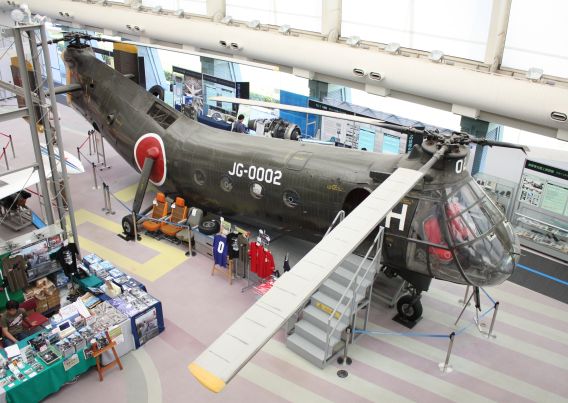
Having had a service career that ran from July 1959 to February 1970, V-44A 50002 ended up
becoming one of the original exhibits at Tokorozawa in April 1993. (Below) The same aircraft
was present when Kisarazu Army Camp opened its doors to the public in October 1979.
(Photo below courtesy Kenju Ohmoto)
Sikorsky H-19C |
|
| Serial | Location |
| 40001 | On indoor display at Tokorozawa Aviation Museum, Saitama Prefecture (see dedicated museum page [link]) To be returned to SDF, date not yet decided (Oct. 2021) |
| 40012 | Derelict at Kawaguchiko Motor Museum, Yamanashi Prefecture (See Aug. 29, 2014, report on Aviation Museums page) |
| Last updated: Oct. 17, 2021 | |
 The Sikorsky H-19C on display at Tokorozawa was handed over to the JGSDF on the day the
The Sikorsky H-19C on display at Tokorozawa was handed over to the JGSDF on the day the
service was formed, July 1, 1954.
(All photographs on this website are copyright J-HangarSpace
unless otherwise stated.)
Displayed Aircraft Special Report 1
KV-107IIA-4, Crossland Oyabe Park, Toyama Prefecture, 2014
To mark the 60th anniversary of Japan’s Self-Defense Forces, J-HangarSpace conducted a census of retired SDF aircraft.
As part of its inquiries into JGSDF aircraft that have passed into civilian hands, in February 2014 J-HangarSpace contacted the city hall in Oyabe, Toyama Prefecture, from where Crossland Oyabe Park is administered. The approach resulted in the supply of information on and the kind donation of photos of the former JGSDF Kawasaki-Vertol KV-107IIA-4 on long-term display there.
Having acquired a manufacturing licence in 1962, on January 31, 1966, Kawasaki handed over the first of 60 KV-107IIs in three variants that were to see service with the JGSDF. The aircraft on display at Crossland Oyabe (51818) was both the last to be delivered and, in March 2002, the last to be retired.
After amassing 5,500 flight hours in a six-unit service career, the aircraft was stored at the Kanto Region Supply Base at Tsuchiura Army Camp, Ibaraki Prefecture, from where it was transported by road to its current location in late July 2004. A nine-man team from JGSDF Yao was in charge of its reassembly.
 Seen here circa 2012, Crossland Oyabe’s KV-107II is parked at the base of an
Seen here circa 2012, Crossland Oyabe’s KV-107II is parked at the base of an
imposing observation tower. (Photo: CROSSLAND OYABE)
A spokesman from Oyabe City Hall informed J-HangarSpace that the aircraft is, strictly speaking, on loan from the JGSDF. This often seems to be the case with ex-JGSDF aircraft on display in public places or used as instructional airframes, for example at flight training academies.
The helicopter offers an added attraction at Crossland Oyabe, which features an observation tower (above) and a huge expanse of grass. Located within the park, the Da Vinci Techno Museum has placed on display one of the helicopter’s two CT58-IHI-140-1 engines. The spokesman also mentioned that the helicopter’s interior is open for viewing by visitors from 2 p.m. to 4 p.m. on wind and rain-free Sundays and National Holidays, but only from April to early November. A shot looking down on the aircraft is possible from the tower’s panoramic observation deck.
The panoramic deck would also be an excellent vantage point from which to view the annual helicopter festival. Usually held on the last weekend in August*, the flying display involves helicopters operated by the JGSDF, rescue services, and civil operators.

(*) The 2017 Crossland Oyabe Helicopter and Fire/Crime Prevention Festival was held on August 26 and 27.
Please visit http://www.city.oyabe.toyama.jp/cross/ (Japanese only) for more details about the park and its facilities.
 Despite its age and being open to the elements, the Crossland Oyabe KV-107II remains in
Despite its age and being open to the elements, the Crossland Oyabe KV-107II remains in
good condition. (Photo: CROSSLAND OYABE)
The Crossland Oyabe aircraft was thus at the start of its static display career when photographed by J-HangarSpace on a visit to Kasumigaura Army Camp, Ibaraki Prefecture, way back in April 2002 (below).
 In 2002, as now, a special marking on the side of the aircraft depicted all the JGSDF units
In 2002, as now, a special marking on the side of the aircraft depicted all the JGSDF units
that had operated the KV-107II.
 Today, visitors to Crossland Oyabe are granted limited access to the
Today, visitors to Crossland Oyabe are granted limited access to the
KV-107II’s cockpit on afternoons from April to November.
 Special report photo update. 51818 on a quiet day in November 2019 (Photo: Warren Hardcastle)
Special report photo update. 51818 on a quiet day in November 2019 (Photo: Warren Hardcastle)
(Above and below) One of 51818′s two CT58-IHI-140-1 turboshaft engines was removed and
placed on display in the lobby of the Da Vinci Techno Museum within Crossland Oyabe park.
(Photos: CROSSLAND OYABE)
Displayed Aircraft Special Report 2
Fuji-Bell UH-1H, Herb World Akita, Yurihonjo, Akita Prefecture (Note: Aircraft removed in 2019)
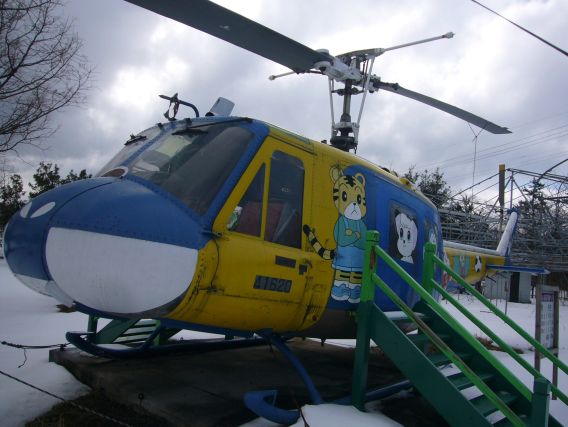
(Above and below) When they added popular cartoon characters to the resident UH-1H,
Herb World Akita employees obliterated the national and unit markings but carefully
painted around the serial numbers on the cockpit doors. (All photos: Herb World Akita)
In early 2014, in the process of searching for information on SDF aircraft that have somehow passed into civilian hands, J-HangarSpace also found references to a cartoon-covered ex-JGSDF Fuji-Bell UH-1H parked among some grape vines in Akita Prefecture. Removed in 2019, the aircraft actually graced Herb World Akita, a shop, craft market, and garden complex in Yurihonjo, Akita Prefecture.
At that time, there was a trend for Japanese towns to merge to gain city status. Up until March 21, 2005, Herb World Akita was located in Nishime, a town of around 6,500 people in Yuri District. The following day, Nishime officially joined four other towns in that part of Akita’s coastal area to form the city of Yurihonjo.
It was during the Nishime town period, now more than 15 years ago, that the word got around that a local JGSDF unit was advertising the loan of a retired helicopter for display purposes.
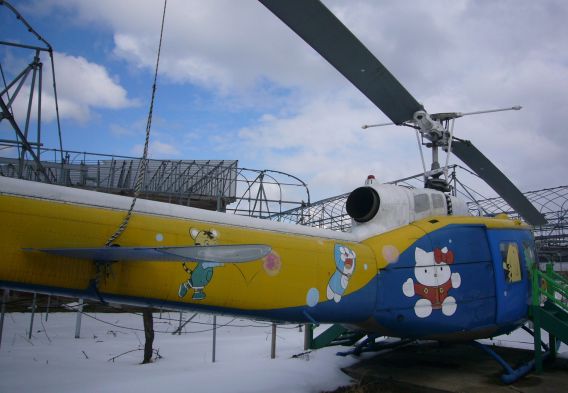 The aircraft is locked by the JGSDF prior to Herb World Akita closing for the winter on
The aircraft is locked by the JGSDF prior to Herb World Akita closing for the winter on
the first Monday in November.
Another this time ongoing trend has been for localities to adopt measures to boost tourism, and Nishime looked into the possibilities and agreed upon the current site for the helicopter. The thinking was that the rarity value of a play area with a real helicopter would provide a unique selling point. The Herb World Akita facilities are closed from the first Monday in November until the National Holiday that marks the vernal equinox in March. Nevertheless, it was hoped that aircraft would offer an added attraction for the many tourists who flock to the area in the peak spring and autumn seasons. A famous local landmark, Mt. Chokai is visible to the south.
When first installed, the aircraft was still sporting its standard drab green camouflage scheme. To make the helicopter more appealing to children, and for them to derive more enjoyment from its presence, Herb World Akita employees were later allowed to paint popular Pokemon and Doraemon cartoon characters on the aircraft.
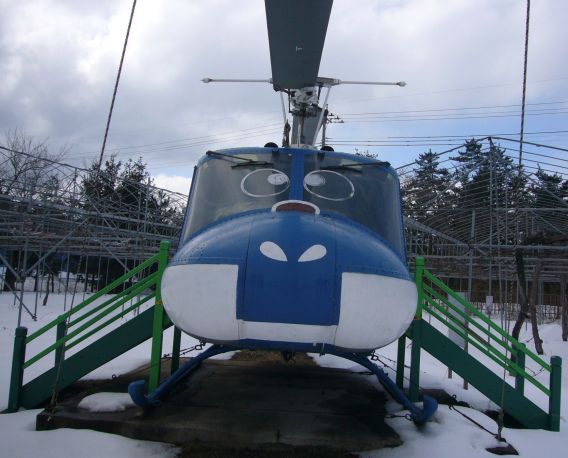
(Above and below) From heard about on the grapevine to parked amid grape vines.
Few would have imagined 41620’s fate when the aircraft entered service in 1975.
For some years, the aircraft had been operated from Kasuminome, Miyagi Prefecture.
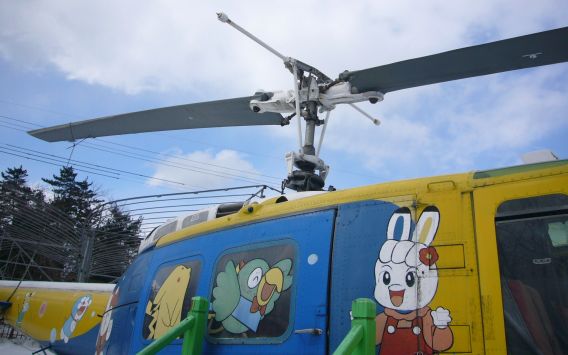 Under the terms of the helicopter’s management contract, JGSDF personnel come to
Under the terms of the helicopter’s management contract, JGSDF personnel come to
carry out a maintenance check once a year.
 Although there were blanks where some of the cockpit instruments once were, Herb World Akita’s
Although there were blanks where some of the cockpit instruments once were, Herb World Akita’s
UH-1H did provide some general details. The red panel in front of the
left-hand pilot’s seat shows operating limits.
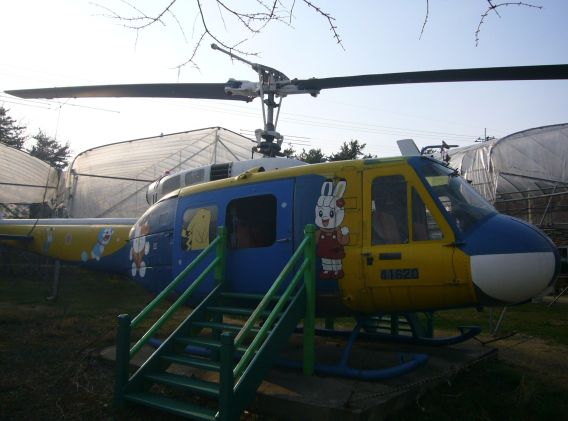 The aircraft awaits Herb World Akita’s first visitors of 2014.
The aircraft awaits Herb World Akita’s first visitors of 2014.
Displayed Aircraft Special Report 3
KV-107II-4A, Kisarazu Army Camp Museum, Chiba Prefecture, September 10, 2017
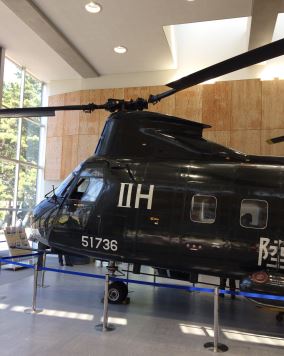
The only one of its kind, the VIP-configured KV-107II-4A 51736 was delivered on March 2, 1972, for a reported cost then of 390.4 million yen. Based on the commercial passenger versions of the type, the aircraft featured larger square instead of circular fuselage side windows and a wider, upgraded forward entrance door and steps.
Two Internet photos show the aircraft in flight at Yokota in November 1986 (link) and in 1994 (link).
 The VIP aircraft is one of those undergoing maintenance at Kisarazu 40 years ago, on
The VIP aircraft is one of those undergoing maintenance at Kisarazu 40 years ago, on
December 24, 1977. (Photo: Akira Watanabe)
This Internet photo records a similar scene in September 1974 (link).
 A far better, full-width photo of the instrument panel can be found by scrolling down here (link)
A far better, full-width photo of the instrument panel can be found by scrolling down here (link)
and compared with that fitted to the standard troop-configured aircraft preserved at Mitsu Seiki
(See Feb. 18, 2014, report on Aviation Museums page).
 The aircraft was able to accommodate a total of 13 passengers in two cabins, the forward
The aircraft was able to accommodate a total of 13 passengers in two cabins, the forward
of which featured a three-seat sofa.
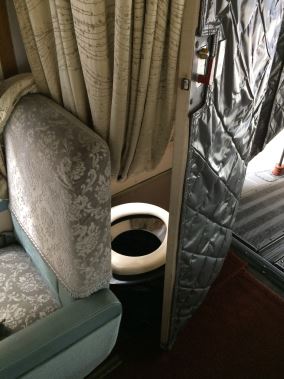 The hardly luxuriously appointed toilet facilities were installed in a space behind the
The hardly luxuriously appointed toilet facilities were installed in a space behind the
rear seats on the starboard side, ahead of the rear cabin door.
The aircraft remained assigned to the 2nd Helicopter Group of the 1st Helicopter Brigade until retired from active service on July 25, 1997, to become an honoured permanent resident at Kisarazu. The sliding doors of its new Kisarazu Army Camp Museum home will still enable the aircraft to be rolled out for special commemorative events, as it has regularly been in the past (as below, in October 2012).
![]()


